初中英语教资考试知识点超详细考点总结
初中英语总复习(全册)知识点归纳
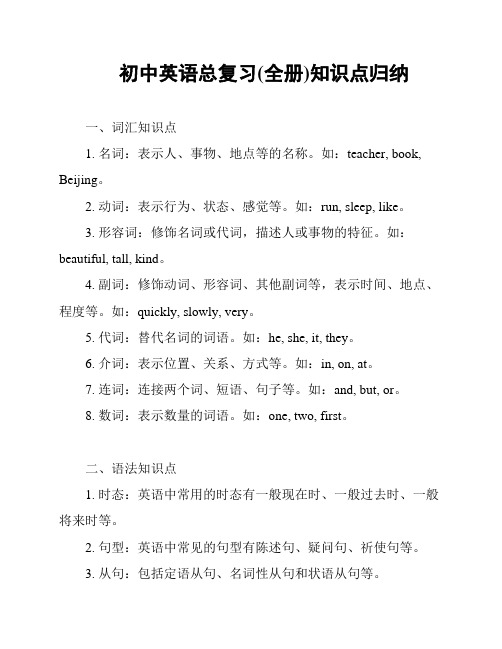
初中英语总复习(全册)知识点归纳一、词汇知识点1. 名词:表示人、事物、地点等的名称。
如:teacher, book, Beijing。
2. 动词:表示行为、状态、感觉等。
如:run, sleep, like。
3. 形容词:修饰名词或代词,描述人或事物的特征。
如:beautiful, tall, kind。
4. 副词:修饰动词、形容词、其他副词等,表示时间、地点、程度等。
如:quickly, slowly, very。
5. 代词:替代名词的词语。
如:he, she, it, they。
6. 介词:表示位置、关系、方式等。
如:in, on, at。
7. 连词:连接两个词、短语、句子等。
如:and, but, or。
8. 数词:表示数量的词语。
如:one, two, first。
二、语法知识点1. 时态:英语中常用的时态有一般现在时、一般过去时、一般将来时等。
2. 句型:英语中常见的句型有陈述句、疑问句、祈使句等。
3. 从句:包括定语从句、名词性从句和状语从句等。
4. 否定形式:在英语中通过在句子中加入否定词来表示否定的意思。
5. 疑问形式:在英语中通过改变句子语序或加入疑问词来构成疑问句。
6. 介词短语:一种由介词和它的宾语构成的结构,用来修饰名词或动词。
三、阅读技巧1. 抓主题:阅读时要注意抓住文章的主题,从中找出关键信息。
2. 理解词义:通过上下文,猜测不认识的单词的意思。
3. 推理推断:通过已知信息进行推理,得出未知信息。
4. 划重点:将文章中所述的重要信息标记出来,有助于记忆和理解。
5. 阅读速度:提高阅读速度的技巧有先读标题、段落开头和结尾。
以上是初中英语总复的知识点归纳,希望对你的复有所帮助!。
初中英语完整知识点总结
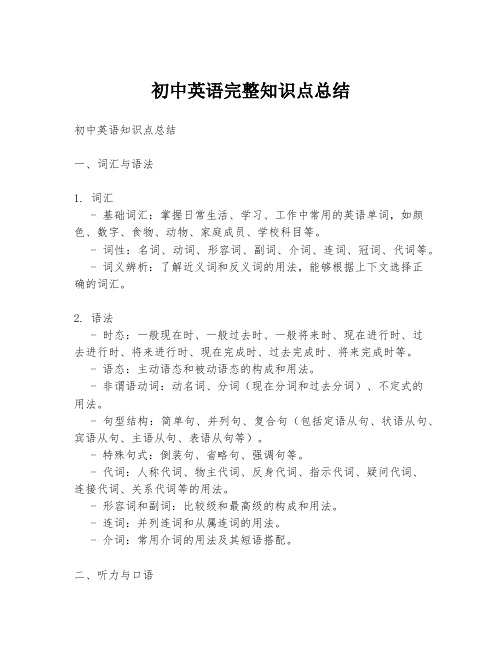
初中英语完整知识点总结初中英语知识点总结一、词汇与语法1. 词汇- 基础词汇:掌握日常生活、学习、工作中常用的英语单词,如颜色、数字、食物、动物、家庭成员、学校科目等。
- 词性:名词、动词、形容词、副词、介词、连词、冠词、代词等。
- 词义辨析:了解近义词和反义词的用法,能够根据上下文选择正确的词汇。
2. 语法- 时态:一般现在时、一般过去时、一般将来时、现在进行时、过去进行时、将来进行时、现在完成时、过去完成时、将来完成时等。
- 语态:主动语态和被动语态的构成和用法。
- 非谓语动词:动名词、分词(现在分词和过去分词)、不定式的用法。
- 句型结构:简单句、并列句、复合句(包括定语从句、状语从句、宾语从句、主语从句、表语从句等)。
- 特殊句式:倒装句、省略句、强调句等。
- 代词:人称代词、物主代词、反身代词、指示代词、疑问代词、连接代词、关系代词等的用法。
- 形容词和副词:比较级和最高级的构成和用法。
- 连词:并列连词和从属连词的用法。
- 介词:常用介词的用法及其短语搭配。
二、听力与口语1. 听力- 听力理解:能够理解日常对话、短文、通知、广告等不同场景的英语听力材料。
- 听力技巧:学会通过上下文、关键词、语调等线索来提高理解能力。
- 听力练习:定期进行听力练习,提高对不同口音、语速的适应能力。
2. 口语- 发音:掌握正确的英语发音规则,包括元音、辅音、连读、失去爆破等。
- 口语表达:能够用英语进行自我介绍、日常交流、描述事物、表达观点等。
- 情景对话:熟悉各种生活、学习、工作中的常见对话场景,并能够进行模拟练习。
- 口语练习:通过角色扮演、小组讨论、演讲等活动提高口语流利度和准确性。
三、阅读与写作1. 阅读- 阅读理解:能够理解不同类型的阅读材料,如故事、科普文章、广告、说明文等。
- 阅读技巧:学会使用略读、查读、精读等策略来提高阅读效率。
- 阅读练习:定期进行阅读练习,拓宽词汇量,提高理解和分析能力。
九年级英语知识点归纳整理

九年级英语知识点归纳整理一、语法知识点。
1. 被动语态。
- 结构:一般现在时的被动语态:am/is/are + 过去分词;一般过去时的被动语态:was/were+过去分词;一般将来时的被动语态:will be+过去分词;含有情态动词的被动语态:情态动词+be +过去分词。
- 用法:当不知道动作的执行者是谁,或者没有必要指出动作的执行者时,使用被动语态。
例如:The bridge was built last year.(不知道谁建的桥,只强调桥被建好了)2. 定语从句。
- 关系代词:that,which,who,whom,whose。
that既可以指人也可以指物;which指物;who指人,在从句中作主语;whom指人,在从句中作宾语;whose表示所属关系,“……的”。
例如:I like the book which/that was written by Lu Xun.(先行词book是物,关系代词可用which或that);The boy who/that is standing there is my brother.(先行词boy是人,关系代词可用who或that作主语)- 关系副词:when,where,why。
when在定语从句中作时间状语;where作地点状语;why作原因状语。
例如:I still remember the day when I first met her.(先行词day表示时间,关系副词用when);This is the place where we used to live.(先行词place表示地点,关系副词用where)3. 宾语从句。
- 语序:宾语从句要用陈述句语序,即“连接词+主语+谓语+其他”。
例如:He asked me where I was going.而不是He asked me where was I going.- 连接词:that(无意义,可省略,在从句中不作成分);if/whether(“是否”,在从句中不作成分);特殊疑问词(如what,when,where,why,how等,在从句中作相应的成分)。
教师资格证考试初中英语科目三必背知识点
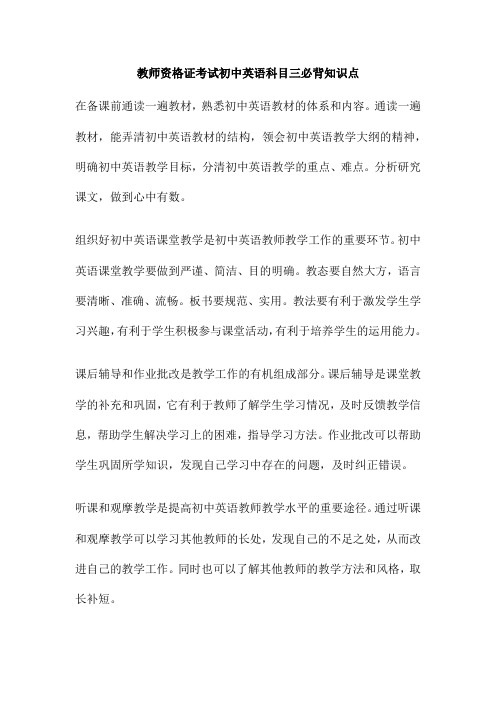
教师资格证考试初中英语科目三必背知识点在备课前通读一遍教材,熟悉初中英语教材的体系和内容。
通读一遍教材,能弄清初中英语教材的结构,领会初中英语教学大纲的精神,明确初中英语教学目标,分清初中英语教学的重点、难点。
分析研究课文,做到心中有数。
组织好初中英语课堂教学是初中英语教师教学工作的重要环节。
初中英语课堂教学要做到严谨、简洁、目的明确。
教态要自然大方,语言要清晰、准确、流畅。
板书要规范、实用。
教法要有利于激发学生学习兴趣,有利于学生积极参与课堂活动,有利于培养学生的运用能力。
课后辅导和作业批改是教学工作的有机组成部分。
课后辅导是课堂教学的补充和巩固,它有利于教师了解学生学习情况,及时反馈教学信息,帮助学生解决学习上的困难,指导学习方法。
作业批改可以帮助学生巩固所学知识,发现自己学习中存在的问题,及时纠正错误。
听课和观摩教学是提高初中英语教师教学水平的重要途径。
通过听课和观摩教学可以学习其他教师的长处,发现自己的不足之处,从而改进自己的教学工作。
同时也可以了解其他教师的教学方法和风格,取长补短。
课外活动是初中英语教学工作的重要组成部分。
通过开展各种形式的课外活动可以激发学生学习英语的兴趣和积极性,增强学生的英语实践能力。
如开展英语角、英语演讲比赛、英语歌曲比赛等活动可以为学生提供运用英语的机会,提高学生的英语口语表达能力。
教学目标是教学实施的基础,也是教学设计的核心。
在教师资格证考试中,初中英语的教学目标应该从语言知识、语言技能、情感态度、学习策略和文化意识五个方面进行描述和设计。
语言知识目标:让学生掌握初中英语的基本词汇、语法和语言表达方式,能够正确地使用英语进行口头和书面表达。
语言技能目标:培养学生的听、说、读、写四项基本技能,使学生能够运用这些技能进行有效的交流和信息获取。
情感态度目标:通过英语学习,培养学生的自信心和积极性,使学生对英语文化和英语国家有更深入的了解,激发其学习兴趣和求知欲。
初中英语知识点最全总结

初中英语知识点最全总结一、词汇与语法1. 词汇积累- 基础词汇:掌握与日常生活相关的基础词汇,如颜色、数字、食物、动物等。
- 主题词汇:根据课程内容,积累与学校生活、家庭、职业、交通等相关的主题词汇。
- 扩展词汇:通过阅读和听力练习,逐步扩展词汇量,包括形容词、副词、动词短语等。
2. 语法结构- 时态:掌握一般现在时、一般过去时、一般将来时等基本时态的构成和用法。
- 语态:了解被动语态的构成和用法。
- 非谓语动词:学习动名词、分词(现在分词和过去分词)的用法。
- 句型:熟悉简单句、并列句和复合句(包括定语从句、状语从句等)的结构和用法。
- 代词:正确使用人称代词、物主代词、反身代词、指示代词、疑问代词等。
- 冠词:掌握不定冠词(a/an)和定冠词(the)的用法。
- 介词:学习常用介词(如at, in, on, for, with等)的用法及其短语搭配。
- 连词:了解并列连词(and, but, or等)和从属连词(because, since, although等)的用法。
二、听力与口语1. 听力技巧- 预测:根据上下文预测对话或短文的内容。
- 捕捉关键信息:在听力材料中快速识别关键词汇和信息。
- 理解语境:通过语调和语气理解说话人的意图和情感。
2. 口语表达- 发音:练习正确的发音和语音语调。
- 情景对话:通过模拟日常情景进行对话练习。
- 描述和叙述:练习描述人物、地点、事件和叙述故事的能力。
- 演讲和陈述:培养清晰表达观点和进行简短演讲的能力。
三、阅读与写作1. 阅读理解- 快速阅读:通过快速阅读抓住文章的主旨大意。
- 细读理解:细致阅读,理解文章的具体细节和深层含义。
- 推理判断:根据文章内容进行逻辑推理和判断。
- 词汇理解:通过上下文猜测生词的意思。
2. 写作技巧- 句子构建:学习如何构建完整、正确的句子。
- 段落写作:掌握段落的结构,包括主题句和支持句。
- 文章组织:学习如何组织文章,使其有清晰的开头、中间和结尾。
初中英语教资考试知识点超详细考点总结

初中英语教资考试知识点超详细考点总结第⼀部分语⾔知识与能⼒第⼀章英语语⾔知识⼆、语⾳(Speech Sounds)P781、语⾳分类发⾳⽅式发⾳部位VL - 清浊⾳(voiceless consonant)VD - 浊辅⾳(voiced consonant)2、⾳系学(phonology)P79(1)同化规则(assimilation Rule)progressive assimilation 顺同化(前⾯带偏后⾯)workedregressive assimilation 逆同化(后⾯带偏前⾯)newspaperreciprocal/double assimilation 互相同化did you(2)⾳节(syllable)tea chi-na im-pos-si-ble重⾳(stress)声调(tone)(3)语⾳变化(vocal variety)liaison 连读pick it upplosion 爆破⾳plosion loss 失去爆破sit down ;incomplete plosion 不完全爆破ask ednasal plosion ⿐腔爆破button ;lateral plosion ⾆边爆破little三、形态学(Morphology)1、morpheme 词素重点!P87(1)free morpheme ⾃由词素dog ;bound morpheme 黏着词素moonwalk(2)root 词根;affix 词缀(prefix 前缀、suffix 后缀);stem 词⼲friend-ships (3)inflectional affix 屈折词缀-s,-ing,-ed不同形式(4)derivational affix 派⽣词缀改变词性和意义2、(1)inflection 屈折变化-s,-ing,-ed不同形式(2)word-formation 词的形成:compounding 复合法through-outderivation 派⽣法(prefixation 前缀化suffixation 后缀化)il-logical-ly3、常见构词法P89invention 新创词nylon ;blending 混成法smoke+fog=smogclipping 截断法advertisement=ad ;initialism ⾸字母连写词WTOacronym ⾸字母拼⾳词AIDS ;back-formation 逆构词法editor--editanalogical creation 类似构词work--wrought/workedtypes of borrowing 借词法:loanword/borrowing 借词feast(法语中借来)loanblend 混合借词Chinatown (本国加外来)loanshift 转移借词bridge (借⽤意义)loan translation 翻译借词(从别种语⾔翻译⽽来)4、词义变化broadening 词义扩⼤bird ⼩鸟--鸟类;narrowing 词义缩⼩girl 年轻⼈--⼥孩meaning shift 词义转移;class shift 词性转换;folk etymology 俗词源(错多了成了对的)四、句法学(Syntax)P911、句法关系syntagmatic relation 组合关系(horizontal relation/chain relation)构成同⼀形式、序列或结构paradigmatic relation 聚合关系(vertical relation/choice relation)各要素可相互替换relation of co-occurrence 共现关系(不同集合的词语⼀起组成句⼦)2、句⼦结构和成分immediate constituent analysis 直接成分分析法(IC分析法)The boy ate the apple. ⽤树形图(tree diagram)⼀般句⼦,主谓宾之类的endocentric construction 向⼼结构⼀个词或词组可以确定为中⼼(center)或中⼼词(head)two stone bridge ⼀般名词/动词/形容词短语exocentric construction 离⼼结构没有确定的中⼼或中⼼词The boy smiled. ⼀般动宾/系表结构deep structure 深层结构(含义相同,说法不同)surface structure 表层结构(句⼦表述⽅式)五、语义学(Semantics)P931、涵义关系(Sense Relations)lexical relation 词汇关系(1)同义关系(Synonymy)synonyms 同义词stylistic ⽂体差别(formality) buy--perchase ;dialectal 地域差别underground--subway collocational 搭配差别accuse(of)--charge(with) ;emotive 情感差别thrifty--stingy ;semantic 语义差别enough--ample(2)反义关系(Antonymy)antonyms 反义词relational opposites 意义相反词gradable antonymy 等级反义warm--cool complementary antonymy 互补反义boy--girlconverse antonymy 反向反义关系buy--sell(3)上下义关系(Hyponymy)种类和成员包括上坐标词(superordinate)和下义词(hyponymy)flower--rose/tulip(4)⼀词多义(Polysemy)(5)同⾳/同形异义现象(Homonymy)homophone 同⾳异义sun--sonhomograph 同形异义liecomplete homonym 完全同⾳同形异义bank 岸边;银⾏2、句⼦逻辑关系iff--充分必要条件“S is true iff P”P就是S的真值条件(truth condition)P (1)synonymy 同义关系“X is synonymous with Y.”同真同假P95(2)contradiction ⽭盾关系“X is inconsistent with Y.”⼀真⼀假(3)entailment 蕴含关系“X entails Y.”X⼩,Y⼤X:old man Y:man(4)presupposition 预设关系“X presupposes Y.”Y是前提X:repair the car Y:have a car六、语⽤学(Pragmatics)P961、⾔语⾏为理论(Speech Act Theory)(1)locutionary act 发话⾏为(说话⼈表达字⾯意思)is the act of saying something which is meaningful an can be understood. (2)illocutionary act ⾏事⾏为(说话⼈表达意图)is the act in saying something to perform a function.(3)perlocutionary act 取效⾏为(作⽤于听话⼈的效果)is the results or effects that are produced by means of saying something. ⾔外之意(illocutionary point):representatives 阐述类;directives 指令类;commissives 承诺类;expressives 表达类;declarations 宣告类2、会话含义理论(Conversational Principle/Maxim)violate 违反P97cooperative principle,CP 合作原则(会话有共同⽬标)“Make your conversational contribution such as is required, at the stage at which it occurs, by the accepted purpose or direction of the talk exchange in which you are engaged.”(1)the maxim of quantity数量准则(信息充分)(2)the maxim of quality质量准则(说实话)(3)the maxim of relation相关准则(说相关的事)(4)the maxim of manner⽅式准则(清楚简洁避免歧义)conversational implicature 会话含义(⽤会话准则暗⽰意义)(1)calculability 可推导性(含义能理解)(2)cancellability 可取消性(defeasibility)(因素变化,含义变化)(3)non-detachability 不可分离性(含义依附于内容)(4)non-conventionality⾮规约性(含义不确定)七、修辞学(Rhetoric)问法:rhetoric/rhetorical device 修辞策略P981、simile明喻like,as...as,as if,as though,similar to,such as2、metaphor隐喻(暗含⽐较)elephant pause3、personification拟⼈(把事物或概念当做⼈)4、metonymy借代(⽤事物的名称代替亲密相关的另⼀事物)5、synecdoche提喻(部分代替整体或整体代替部分)hand/mouth--man6、euphemism婉⾔die--pass away7、irony反语(意思相反)8、allegory讽喻9、exaggeration夸张(夸⼤或缩⼩使表达⽣动有趣)10、transferred epithet移位修辞nervous exam11、oxymoron⽭盾修辞bitter-sweet memory12、pun双关语(homophonic puns 谐⾳双关;homographic puns 语义双关)⼋、语⾔教学P1001、中介语(interlanguage)2、对⽐分析(contrastive analysis)3、错误分析(error analysis)(1)error错误(因为知识不⾜)mistake失误(不注意犯错)(2)interlingual errors语际错误(迁移错误)因为母语Cnglishintralingual errors语内错误(发展性错误)因为过度概括语⾔规则eat-eated(错) 4、错误性质:omissions 省略(少成分);additions 添加(多成分);misformations 形式错误(eated);double markings 双重标记(didn’t went);misorderings 顺序错误(how you are)5、我国外语学习者错误类型(1)negative transfer 负迁移/⼲扰因为母语(2)over-generalization过度类推/过度概括因为过度概括语⾔规则(3)pragmatic failure语⽤错误违反对⽅的⽂化习俗6、第⼆外语习得理论(Second Language Acquisition,SLA)(1)Acquisition-Learning Hypothesis语⾔习得和学得假说(习得和学得两条不同的途径)(2)Monitor Hypothesis语⾔监察假说(学习者⾃⼰监督控制语⾔输出质量)(3)Input Hypothesis语⾔输⼊假说(接触理解可理解性语⾔输⼊comprehensible input)(4)Affective Filter Hypothesis情感过滤假说(输⼊input和吸收intake受到动⼒motivation、性格personality、情感状态affective state)(5)Natural Order Hypothesis⾃然顺序假说(可以不按任何语法顺序来教学)第⼆章英语语⾔运⽤能⼒⼀、教学中的⾮语⾔交际1、⾮语⾔⼿段P118environment language环境语(座位安排、时间信息、室内标⽰装饰、声⾳灯光等)object language客体语(个⼈,⾐着化妆、个⼈⽤品等)2、⾮语⾔⾏为body language体态语(⾝姿、⼿势、表情、⽬光)paralanguage 副语⾔(声⾳⾳质、⾳量、语调、语速)第三章英语国家的语⾔、历史和⽂学三、语⾔、⽂化和社会1、局部结构P131毗邻对(adjacency pairs)⼀轮对话(1)毗邻对的条件相关性(conditional relevance)preferred second part/preference structure 优选结构Hidispreferred second part/dispreference structure ⾮优选结构relevant absence 相关缺失(2)毗邻对的扩展base pairs 根毗邻对(被其他会话扩展之前的毗邻对)前扩展,指前序列(pre-sequences),包括邀请、请求、结束、宣告中扩展,包括插⼊序列(insertion sequences)和旁侧序列(side sequences)后扩展,指后序列(post sequences),包括会话修正和主体化2、会话修正会话修正机制三个部分:修正源(trouble source)、修正的发起(repair initiation)、修正(repair)lexical 词汇启动(no,sorry,let me see,you know)non-lexical ⾮词汇启动(um..,uh..)四、语⾔与⽂字1、⼩说语⾔P134(1)⼩说与视⾓first-person narrator 第⼀⼈称叙述者(I)third-person narrator第三⼈称叙述者(he,she,it,they)(2)语⾔表达与思想表达direct speech 直接⾔语(“F**k you”)indirect speech间接⾔语(he said/asked)free indirect speech ⾃由间接⾔语第⼆部分语⾔教学知识与能⼒第⼀章初中英语课程标准⼀、初中英语课程基础知识1、英语课程的性质P149The nature of English Curriculum is instrumentality/tool and humanity.(⼯具性和⼈⽂性)Students’ overall development is the motivation and goal of the English curriculum.2、英语课程的设计思路The design of the new National English Curriculum unifies both primary and secondary school English into one continuum of development and divides English language teaching and learninginto nine competence-based levels by adopting the international general classification method. Level 5 is the required standard for the end of junior middle school. Level 2--primary school⼆、英语课程的分级标准P1541、语⾔技能(Language Skills)Overall performance objectives for each level are given in addition to detailed descriptions of abilities regarding language knowledge, language skills, affect, learning strategies as well as cultural awareness for relevant levels.2、语⾔知识(Language Knowledge)(语⾳、词汇、语法、功能和话题)Students are required to learn consists of phonetics, vocabulary, grammar, function and theme.3、情感态度(Affect)(兴趣、动机、⾃信、意志和合作精神;祖国意识和国际视野)interest, motivation, confidence, will and cooperation; National consciousness and international vision.4、学习策略(Learning Strategies)(认知、调控、交际、资源)Learning strategies can be classified into four groups: cognitive strategy, regulative strategy, communicative strategy and resourcing strategy.5、⽂化意识(Cultural Awareness/Understanding)(历史地理、风⼟⼈情、传统习俗、⽣活⽅式、⾏为规范、⽂学艺术、价值观念)Historical geography, local customs, traditional customs, lifestyle, norms of behavior, literature and art, values.三、英语课程的实施建议P1611、教学建议(1)⾯向全体学⽣,为每个学⽣学习英语奠定基础(2)注意语⾔实践,培养学⽣的语⾔运⽤能⼒(3)加强学习策略指导,培养学⽣⾃主学习能⼒(4)培养学⽣的跨⽂化交际意识,发展跨⽂化交际能⼒(5)结合实际教学需要,创造性地使⽤教材(6)合理利⽤各种教学资源,提⾼学⽣的学习效率(7)组织⽣动活泼的课外活动,拓展学⽣的学习渠道(8)不断提⾼专业⽔平,努⼒适应课程要求第⼆章初中英语教学基本理论⼀、语⾔观(Views of Language)P1731、语⾔的概念Language is a system of arbitrary vocal symbols used for human communication.2、语⾔的本质特征/设计特性(design features)(1)arbitrariness 任意性(体现了convention规约性)(2)duality ⼆重性(basic level, higher level基层和⾼层)(3)creativity 创造性/productivity能产性(4)displacement 移位性(赋予generalizations, abstractions概括和抽象)(5)cultural transmission ⽂化传习性3、语⾔的功能(Functions of Language)(1)informative function信息功能(2)interpersonal function⼈际功能(3)performative function施为功能(4)emotive function情绪功能(5)phatic function寒暄功能(6)recreational function娱乐功能(7)metalingual function元语⾔功能4、语⾔学⾓度的语⾔观(1)The Structural View of Language 结构语⾔观the structural view sees language as a linguistic system made up of various subsystems: phonology, morphology, lexicology and syntax.(2)The Function View of Language 功能语⾔观the function view sees language not only as a linguistic system but also as a means for doing things.(3)The Interactional View of Language 交互语⾔观(interaction, dynamics交互性和动态)the interactional view of language considers language as a communicative tool, whose main use is to build up and maintain social relations between people.⼆、语⾔学习观(Views of Language Learning)P1761、语⾔学习理论(1)Behaviorist Learning Theory ⾏为主义学习理论Behaviorism is an approach to psychology that arouses out of the ideas that attempted to explain all learning in terms of some form of conditioning (stimulus, response, and reinforcement)(2)Cognitive Learning Theory认知主义学习理论Cognitive theory thinks that “language is a intricate rule-based system and with a knowledge of the finite rules (language competence), infinite sentences can be produced”.(3)Constructivist Learning Theory构建主义学习理论The constructivist theory believes that learning is a process in which the learner constructs meaning based on his own experiences and what he already knows.最近发展区理论Zone of Proximal Development三、语⾔教学观(Views of Language Teaching)P1781、语⾔教学理论(结构主义教学理论、认知主义教学理论、社会语⾔学理论)四、外语教学法的主要流派1、grammar-translation method 语法翻译法2、audio-lingual method 听说法(pattern drill 句型操练、contrastive analysis对⽐分析法)3、total physical response 全⾝反应教学法P1814、cognitive approach 认知教学法(提⾼accuracy, appropriateness得体性)5、communicate approach 交际法(包含function,notion功能和意念)P183(1)交际能⼒(communicative competence)grammatical competence 语法能⼒、sociolinguistic 社会语⾔能⼒、discourse 语篇能⼒、strategic 策略能⼒、linguistic 语⾔能⼒、pragmatic语⽤能⼒、fluency流利性(2)3P教学模式:presentation--practice--production6、task-based approach任务型教学P184(1)real-world tasks /target tasks ⽬标任务;pedagogical tasks 教学任务(2)任务的四个构成元素:objective、context、process、outcome(3)information gap 信息差/信息沟activities must have clear and attainable objectives./should be confined to the classroom context./should help develop students’ language ability.(4)constructivism learning theory建构主义学习理论(强调scene, writing, conversation, and meaning construction情景、写作、会话和意义建构)(5)任务型教学的三个环节:pre-task前任务、task-cycle任务环(task、planning、report)、language focus语⾔聚焦(analysis、practice)第三章初中英语语⾔知识教学⼀、语⾳教学P1921、语⾳教学的内容The realistic goal of teaching pronunciation should be①consistency: the pronunciation should be smooth and natural.②intelligibility: the pronunciation should be understandable to the listeners.③communicative efficiency: the pronunciation should help convey the meaning that is intended by the speaker.2、Pronunciation knowledge teaching发⾳知识教学(monophonic, alphabet, phonetic symbols单⾳、字母、⾳标)3、Flow of language teaching语流教学(sounds, stress, rhythm, and intonation重⾳、节奏、语调)4、The principle of phonetic teaching语⾳教学的原则(accuracy, long-term, integrity, communication, pertinence, interest准确性、长期性、整体性、交际性、针对性、趣味性原则)5、The teaching method of phonetics语⾳的教学⽅法P195(1)Sound perception听⾳感知练习⽅法:using minimal pairs 最⼩对⽴体(live--leave)、which order 排序、same or different 辨别异同、odd one out 同中选异、completion 填空(2)Imitation and explanation 模仿讲解personally demonstration、imitate、practice亲⾃⽰范,反复模仿、练习(3)Pronunciation practice发⾳练习练习⽅法:listen and repeat 听⾳模仿、fill in the blanks 填空、using pictures 借助图⽚、using meaningful context 借助情景make up sentences 造句、using togue twisters运⽤绕⼝令(4)语流教学(见上)慢动作(slow motion speaking)⼆、词汇教学P197 language teaching theories 理论构成:receptive/passive vocabulary 接受性/消极词汇和productive/产出性/积极词汇1、Learning content教学内容(1)word meaning 词汇的意义include learning form,meaning and use.Knowing a word means: knowing its pronunciation and stress/ its spelling and grammatical properties/ its meaning/ how and when to use it to express the intended meaning.词汇意义包括conceptual meaning 、associated meaning 概念意义和关联意义概念意义:词典中意思,即literal meaning/ denotation 字⾯意思/词汇的外延、关联意义:⽂化含义与语境意义,⼜称connotation 词汇的内涵( learn in the context )(2)word use 词汇的⽤法包括:collocation/ phrases/ idiom/ style/ register 搭配、词组、习语、风格、语域(3)word information 词汇信息包括:part of speech/ prefixes/ suffixes/ spelling/ pronunciation/ grammar features 词类、前缀、后缀、拼写、发⾳、语法特征(4)word memory strategies 词汇记忆策略avoid rote-learning 避免死记硬背word-building构词法猜测词义2、Learning principle教学原则(1)⾳形义结合pronounce、spelling、meaning(2)词块整体教学lexical chunks ( knowledge of collocation 搭配)(3)具体语境中教learn in the context(4)循序渐进step by step(5)反复练习巩固记忆review(6)培养⾃学词汇能⼒deduce the meaning of words猜测词义3、Teaching method教学⽅法P200(1)呈现词汇:visual/physical demonstration 直观呈现Word-building 构词法、synonym/antonym(opposites)同义反义词、翻译、举例、问答verbal context/ situation 结合语境/创设情境运⽤词汇学习策略,如chunks/ reasoning/ analog/ using dictionary归类/推理/类⽐/查字典(2)巩固词汇:labelling/ spot the difference/ describe the draw/ play a game/ word bingo/word association 贴标签/找茬/描述绘画/玩游戏(宾果)/词汇联想三、语法教学P2011、Content 教学内容grammar语法具有Three dimensions三维性:form, meaning and usage形式、意义和⽤法semantic语义包括grammatical form/the grammatical meaning of the structure/contents of meaning语法形式、结构的语法意义和内容意义task 教学任务:语法rules规则的cognition/ drill/ application认知/操练/应⽤、the generation of grammar consciousness语法意识的⽣成2、Principle 教学原则(交际性/实践性、集中分散相结合、趣味性/通俗性)grammar teaching should be:(1)collocational:the grammar should be built on collocational relations between individual lexical items and their subcategories.(2)Constructive:one's knowledge of grammar is built bit by bit,which closely model the way language is learned and used.(3)Contextual:syntactic and lexical choices are explicitly related to pragmatic ones,and to social and cultural contexts.(4)Contrastive:grammar involves drawing the learner's attention to contrast the differences between the target language and other languages,and between sets of similar features and items of the target language.3、Method教学⽅法P202(1)deductive method 演绎法(讲解规则,结合实例分析⽤法,句型练习)features: It saves time/pays more attention to form/teaches grammar in a decontextualized situation脱离上下⽂(2)inductive method 归纳法(学⽣⾃⾏归纳语法规则)start with examples and guides ss to work out the rules(3)guided discovery method 引导发现法(学⽣归纳总结语法规则,⽼师强化其形式意义)四、语篇教学P2041、概念和结构(1)Conception 概念discourse pattern语篇可以是dialogue、monologue对话、独⽩,包括written/spoken language 书⾯语、⼝语,form形式上是cohesion衔接的,semantic语义上是coherence连贯的(2)Tactic pattern结构模式语段/句群、句际关系(并列、顺序、层递、转折)(3)Cohesive device 衔接⼿段logical connectors逻辑纽带(firstly, thus, on the other hand, if not)grammatical connectors语法纽带(时态什么的)Lexical connectors词汇纽带(repetition重复、synonym/antonym(opposites)同义/反义词)Develop ss’ skill of recognizing discourse patterns训练⽅式:checking the logic of the author’s arguments.getting the scrambled sentences into a paragraph.(focus on textual coherence)marking out common openers to stories and jokes.2、教学内涵Aims at developing ss’ discourse awareness.(teacher asks ss to concentrate on such features as structure, coherence and cohesion of a text)3、教学⽅法P207overall effectiveness整体性效能(⽤knowledge transfer知识迁移实现,重在cultivate application ability应⽤能⼒培养)、overall grasp of the discourse语篇的整体把握Teaching language at the discourse level :utterance function / expected response/ congratulation/ apology/ acceptance/ inform.第四章初中英语语⾔技能教学P212⼀、听⼒教学1、影响听⼒的主要因素(1)objective factor客观因素:types of language used 语⾔特征(语速/tone⾳调/pause停顿/liaison连读)、task or purpose in listening 听⼒任务、context in which the listening occurs ⽂化背景知识(2)subjective factor主观因素:psychological⼼理因素、knowledge skills知识技能因素、methods and tactics⽅法与策略因素2、听⼒教学的要领(1)合理选择听⼒material材料(authenticity真实性、intelligibility可理解性、diversity/variety 多样性)(2)建⽴专门的听⼒training system训练体系(3)优化⼼理氛围,降低焦虑感(arouse interest调动兴趣、放松)(4)重视听的过程中的skill training技巧训练prediction 预测、guess 猜测、coherent memory 连贯记忆(note-taking)、identifying the discourse markers辨认语段标记(5)科学设计听⼒练习3、听⼒训练的type类型P216(1)Focus listening精听(tonal discrimination辨⾳、gap filling填空、dictation听写)听写形式:dictogloss听释、fast-speech dictation快速听写、pause and paraphrase听写⼤意、listening cloze 完形听写、error identification纠错听写、jigsaw identification线索听写(2)Gist listening泛听( decide on the best title )(3)Free listening随意听4、听⼒教学model模式(1)Bottom-up model“⾃下⽽上”(强调language knowledge语⾔知识)(2)Top-down model“⾃上⽽下”(侧重background information背景知识)5、听⼒教学的过程P218(1)Pre-listening tasks 听前环节(brainstorming/discuss a relevant picture/writing question about the topic/associating vocabularies with the topic)(2)While-listening tasks听中环节(辨⾳、获取主要信息、预测、猜词悟义)(3)Post-listening tasks 听后环节(writing a similar text作⽂、discussion讨论)⼆、⼝语教学P2191、Spoken language⼝语的特点(fragmentation结构不完整性、involvement⼈和场合紧密依存性)(1)语法特征:There are four common features of spoken language:Using less complex syntax.语法Taking short cuts,e.g.incomplete sentences.(and, or,but)Using fixed conventional phrases/chunks.俗语(fashionable word, two-part allegorical saying,colloquialism,slang,phrasal verbs 歇后语/⼝语词/俚语/短语动词)Using devices such as fillers,hesitation device to give time to think before speaking.结构特征:往往借助filler补⽩词(you know, let me see, um)形象特征:说话⼈的表情、语⽓及态度等body language⾝体语⾔;⾳质/声调/重⾳/停顿(2)⼝语的交际特点“说”受语⾔rule规则⽀配/时间factor因素制约/对⽅response反应影响2、⼝语教学的要领(1)在听的基础上培养说的能⼒(使输⼊的信息量⼤于输出的信息量)(2)组织多样化的⼝语活动形式⼝语活动类型:pre-communicative activities 前交际活动(操练/模仿/重复)和communicative activities 交际活动(信息差活动/解决问题活动/讨论/辩论/采访/游戏)(3)正确处理准确与流利的关系Accuracy( identify particular phonemes on tape )Fluency( shouldn’t interrupt )(4)创造浓厚外语氛围,⿎励学⽣敢说乐说The characteristics of a successful speaking task:maximum foreign talk/even participation/high motivation/right language level(5)合理选择⼝语组织形式,增加学⽣开⼝的机会(⼩组形式/单双⼈活动)3、⼝语训练的⽅法imitativeness模仿性、monologue独⽩性、performing表演性的⼝语表达三、阅读教学P2231、外语阅读的type/form类型(1)根据阅读⽅式和技巧的不同划分Adaptive reading适应性阅读recognition--read--silent-reading认读--朗读--默读Learning reading学习型阅读plain substance主旨浅显information信息量⼤,强调阅读速度comprehension理解性阅读real material材料真实、wide theme题材⼴泛、various types体裁多样,higher difficulty 难度较⾼(2)根据阅读⽅式和技巧的不同划分Skinning ⾯式读法/略读(掌握全⽂⼤意或中⼼思想;报刊、新书)quickly get the gistScanning 点式读法/寻读/跳读(查找具体信息;时间、⼈名、地点、数字)specific informationIntensive reading 线式读法/精读(详细地阅读,深⼊分析、理解和记忆)read in detailExtensive reading 纵式读法/泛读(⼴泛地阅读,阅读速度、快速理解能⼒、拓宽视野)facilitate process of accumulating vocabulary / increasing target language expose/ broadening scope of vision(3)根据阅读理解的层次划分Literal comprehension 字⾯理解(依靠语⾔知识/能⼒辨认词义和语法结构)language knowledge/competence identify meaning and grammatical structureInferential/interpretive comprehension 推断性理解(经历、直觉、逻辑判断理解未明⽰信息)experience/ intuition/ logic judge and understand unexpressed informationEvaluative comprehension 评价性理解/应⽤性理解(理解⽂章信息的价值)valueAppreciative comprehension 欣赏性理解(情感熏陶和思想启迪)Emotional influence and thought enlightenment2、阅读教学的要领P226(1)合理选择阅读材料Language difficulties 难度(难于略⾼于学习者现有⽔平)higher than present levelInterest 趣味性(充满可读性,激发求知欲和好奇⼼)readability、thirst for knowledge and curiosityAuthenticity 真实性(英语本族语者撰写)written by native English speakersComprehensiveness 宽泛性(内容反映历史、⼈物、风⼟⼈情、⽂化习俗以及时尚流⾏,体裁和题材丰富多样)content various type or forms of literature and theme(2)建⽴分析性(精读)与综合性(泛读)相结合的阅读教学体系分析性阅读与综合性阅读教学的分⼯改进现⾏分析性阅读教学模式,落实阅读训练综合性阅读教学应正规化、课程化(3)重视阅读three elements三要素的培养vocabulary词汇、comprehend理解(topic sentence主题句)、speed速度(4)重视阅读过程中的技巧训练prediction预测、reading for specific抓中⼼思想、reading for specific information获取特殊信息、inferring推理(reading between the lines)、identifying the discourse types确认语篇3、阅读教学的approach模式P229(1)The top-down model ⾃上⽽下模式为主(pre-reading activities读前环节活动的开展)(2)The bottom-up model ⾃下⽽上模式为辅(⼩到⼤的语⾔⽂字单位,重视词汇教学)teaching a text by introducing new vocabularies or structuresfollow the sequence of teaching new words, sentences and then the whole passage(3)The interactive-compensatory approach交互补偿模式4、阅读教学的过程(1)Pre-reading tasks 读前环节(背景知识、写作风格、西⽅风俗)predicting what a passage is about/ creating a word web related to a topic/ sharing what is already known about a topic (2)While-reading tasks读中环节(保障充⾜阅读时间、阅读技能训练)(3)Post-reading tasks 读后环节(思维和实践活动)四、写作教学P2311、写的教学要领(1)Motivate writing motivation 激发写作动机communicative purpose; audience awareness 交际⽬的读者意识(2)指导写作技巧:写的单项训练(结合语⾳教学)语篇写作技巧(design skills构思技巧;过程构思、⽂本构思;model essay范⽂是有⼒⼯具)skill of planning: finding ideas and put them in order(3)根据不同⽂体风格指导相应的写作策略Formal writing 正式⽂体(第三⼈称)typical feature: the precision of language is a priority 语⾔精确优先well-organized structure 有序的结构wide range of vocabulary and structural patterns 有结构的模式technical terms and definitions 专⽤名词和定义Informal writing ⾮正式⽂体(⼀、⼆⼈称)typical feature: short and incomplete sentences are common 多为短句、简单句(4)分阶段设计教学活动,训练写作技能Controlled writing 控制性写作(gap filling/ transcribe/ sentence pattern transformation填空/抄写/句型转换)Guided writing 指导性写作(completion/ reproduction/ compression/ transformation 续写/复写/缩写/转写)Free writing ⾃由写作(5)写、correct/ amend改、evaluate评相结合2、写作教学的模式(1)Product-oriented approach注重结果(给题⽬--写--改,注重语篇整体)(2)Content-oriented approach注重内容(收集材料--组织⽂章--修改,写前准备)(3)Process-oriented approach注重过程(准备--写作--修改--再改,写作能⼒)what/how to write peer-editing3、写作教学的process过程(1)Pre-writing tasks写前环节的任务和活动(gather and organize ideas激发写作动机)The main procedures of process writing include creating a motivation to write, brainstorming,mapping,freewriting,outlining,drafting,editing,revising,proofreading and conferencing.(2)While-writing tasks写中环节的任务和活动(organize written组织成⽂)drafting, peer-editing, revising(3)Post-writing tasks写后环节的任务和活动(comments and feedback 点评和反馈)conferencing第三部分教学设计第⼀章教学设计skill技能⼀、教学设计概述P2411、概念:传统的instructional design 教学设计即lesson planning 备课考虑“如何学”最核⼼的部分是lesson plan 教案It’s a teaching guide/ It takes into account syllabus教学⼤纲and ss./It describes in advance提前what about how to teach.2、教学设计principle原则aims⽬标性原则variety 多样性原则flexibility 灵活性原则learnability可学性原则linkage 衔接性选择feasibility 可⾏性原则3、教学设计的basic requirements基本要求A language lesson plan usually has the following components:background information, teaching aims, language contents and skills, stages and procedures, teaching aids, assignments, and teacher's after-lesson reflection.4、教学设计新concept理念(1)学⽣参与课堂设计的⾃主性(2)教学设计贯穿课堂教学的全过程(3)教学设计的确定性与不确定性相统⼀5、教学设计的pattern模式Analysis----design----evaluation 分析----设计----评价分析:学习需求(学习objectives⽬标分析是关键)、学习者、学习content内容设计:教学strategy策略、教学course过程(task appearance--preparation--accomplishment--consolidation 任务呈现--任务准备--任务完成--语⾔巩固)、教学technique技术评价:教学target⽬标是否达成是评价教学设计有效性的关键反馈修正(feedback correction):教学评价能够提供⼤量的教学反馈信息6、英语教学设计的concrete form 具体形式(1)表格式table form分别陈述学⽣/教师活动,说明活动⽬的/意图,突出教学design设计的理念(2)流程图式flow chart form 展⽰教学process过程(format格式不同)(3)叙述式narrative form⼆、学情分析P2481、学习者分析(1)认知特征(2)学习风格authority-oriented learners崇尚权威型;analytical learners分析型;concrete learners具体型;communicative learners交际型(3)学习⽅式accepted 接受性;experience 体验性;independent ⾃主性;Cooperation 合作性;exploration 探究性2、学习需求分析(1)learning needs的内涵学习⽬前状态与期望状态之间的差距(2)学习需求分析的内容和⽅法data collection 数据采集;analyze 分析三、教学内容分析P2511、教学内容的选择把握fundamentality基础性(vocabulary/ syntactic structure/ language competence/ learning strategy/ cultural knowledge词汇/句法结构/语⾔能⼒/学习策略/⽂化知识)adaptation 适应性(age/ cognitive characteristic 年龄/认知特点)high frequency⾼频性(frequently used经常使⽤的)enjoyment 趣味性(激发学习兴趣,保证学习effectiveness 有效性)2、正确理解textbook教材(1)分析教材textbook evaluation provides authentic language/ matches the needs of learners/ can help realize the objectives of a language program(2)处理教材的⽅法(LARA法:leave-adapt-replace-add)(3)教材的使⽤:活化教材、挖掘资源、选准话题(探究性、开放性、⽣成性)When a teacher using an ELT course book, he should:select appropriate supporting materials and resources.interpret curriculum goals and its expectations for the course.plan lessons in relation to specific goals, topics, texts, and tasks.3、Auxiliary teaching materials辅助教学材料的screening筛选(1)教学材料筛选的原则:启发式、因材施教、动态⽣成、适时适度(2)教学材料筛选的策略:遵循理念、吃透教材、研究学⽣(3)辅助教学材料的分类:知识类、技能类、课外活动类、教学辅助类、⾃主学习类四、教学⽬标P2551、教学⽬标的陈述内容三个维度:knowledge objective/ ability objective/ emotion objective知识与技能、过程与⽅法、情感态度与价值观2、教学⽬标的陈述要素以⾏为⽬标来陈述教学⽬标,包括四个要素:ABCD模式A-audience 主体或听众(程度副词/百分⽐/范围副词)+主语(ss/learners)B-behavior ⾏为listen,sing,imitate,recite,depict,recognize,apply,understand,know,master,enjoyC-conditions 条件after this class, under the guidance of the teacher, after attending a lecture,with the help of substances, through imitation/repeatD-degree 程度/标准clearly, fluently, correctly, efficiently, basically, preliminarily, smoothly, appropriately 3、教学⽬标的陈述⽅式按照层级划分有三种goals,aims,objectives(course goals, teaching aims)(1)结果性⽬标(知识与技能)4、教学⽬标的陈述原则comprehensive、suitable、specific、accurate全⾯、恰当(⽬标层次性/内容和已有知识⼀致性/教学活动连贯性)、具体、准确五、教学重难点P2591、教学重难点的meaning涵义(1)Teaching key/ Important point教学重点称为subject学科教学的core knowledge核⼼知识(2)Teaching difficult point 教学难点(3)教学重难点的relation关系教学重点:stability、chronicity 稳定性、长期性教学难点:temporary、relativity 暂时性、相对性2、教学重难点的确定(1)深刻理解课程标准熟悉和贯彻执⾏课程标准的内容要求(2)深⼊研究教材教材是教学的主要依据(3)了解学⽣的实际情况学⽣是教学的对象/主体(4)善于总结经验虚⼼学习、不断提⾼⾃⾝教学素质和能⼒3、突出重点、突破难点的method⽅法metaphor description⽐喻说明法、list comparison 列表对⽐法、exercise 练习法、Multimedia assisted instruction 多媒体辅助教学法、game activity游戏活动法六、教堂教学process过程设计P260教学过程(teaching procedure)实现教学、发展和教育三⼤功能1、课堂导⼊活动的设计Lead-in导⼊应达到“3A”的功效:arouse激励启发;advertise引起注意;advance促进(1)课堂导⼊的⽅法复习导⼊法(新旧知识的联结点)、直观导⼊法(直观教具或多媒体⼿段)情境导⼊法(duty report/⾳乐/故事/游戏导⼊)、悬念导⼊法(呈现⼀系列问题)(2)注意事项导⼊时间不宜过长(5’/45’);符合教学⽬标/内容;从学⽣实际出发(年龄、性格、认知特征);⽅式新颖有创意2、语⾔学习与实践活动的设计(呈现、讲解、练习巩固和实践新语⾔知识)(1)呈现活动的设计(presentation)问题呈现、情景呈现、故事呈现(完整故事贯穿整个课堂教学)、直观呈现(简笔画/图⽚/模型/幻灯⽚/⾝势语)(2)练习与巩固活动的设计(practice and consolidate)机械性练习mechanical exercise 控制式的练习频率⾼⽆需过多思考,不超过8min,1~2项练习内容,学⽣个体/全班练习为主,⽴即纠错练习形式:模仿、跟读、重复、替换练习、简单回答活动半开放性练习semi-open practice 半控制式的意义性练习。
初中英语知识点重难点总结
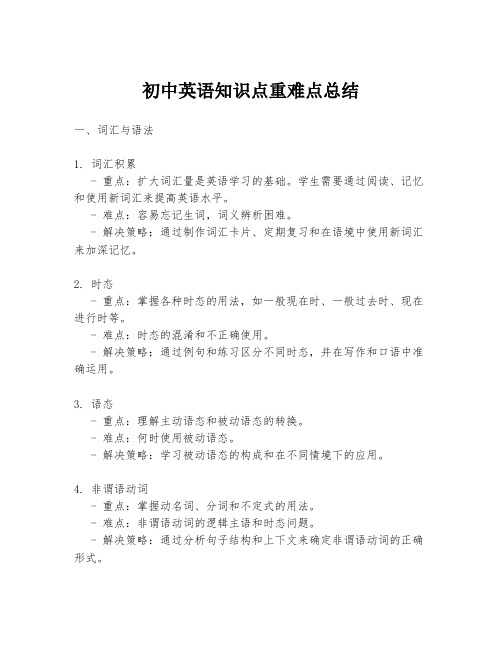
初中英语知识点重难点总结一、词汇与语法1. 词汇积累- 重点:扩大词汇量是英语学习的基础。
学生需要通过阅读、记忆和使用新词汇来提高英语水平。
- 难点:容易忘记生词,词义辨析困难。
- 解决策略:通过制作词汇卡片、定期复习和在语境中使用新词汇来加深记忆。
2. 时态- 重点:掌握各种时态的用法,如一般现在时、一般过去时、现在进行时等。
- 难点:时态的混淆和不正确使用。
- 解决策略:通过例句和练习区分不同时态,并在写作和口语中准确运用。
3. 语态- 重点:理解主动语态和被动语态的转换。
- 难点:何时使用被动语态。
- 解决策略:学习被动语态的构成和在不同情境下的应用。
4. 非谓语动词- 重点:掌握动名词、分词和不定式的用法。
- 难点:非谓语动词的逻辑主语和时态问题。
- 解决策略:通过分析句子结构和上下文来确定非谓语动词的正确形式。
5. 句子结构- 重点:理解和构建简单句、并列句和复合句。
- 难点:复合句中从句的引导词选择和使用。
- 解决策略:通过图示和实例学习不同从句的用法,并进行针对性练习。
二、阅读理解1. 阅读技巧- 重点:提高阅读速度和理解能力。
- 难点:生词多、长句理解困难。
- 解决策略:学习略读(skimming)和扫读(scanning)技巧,通过上下文推测词义。
2. 信息获取- 重点:准确获取文章主旨和细节信息。
- 难点:区分事实信息和作者观点。
- 解决策略:练习从文章中提取关键信息,并学会区分不同类型的信息。
3. 推理判断- 重点:培养逻辑推理和判断能力。
- 难点:根据文章内容进行合理推断。
- 解决策略:通过练习题目提高推理能力,学习如何根据线索进行推断。
三、写作技巧1. 文章结构- 重点:掌握英语写作的基本结构,包括引言、正文和结尾。
- 难点:组织文章和过渡自然。
- 解决策略:学习使用连接词和过渡句,练习写作提纲的编写。
2. 表达清晰- 重点:确保写作内容清晰、准确。
- 难点:避免语法错误和不清晰的表达。
初中英语知识点全汇总

初中英语知识点全汇总英语作为一门国际通用语言,在今天的学习和工作中扮演着重要的角色。
对于初中生来说,掌握一些基本的英语知识点是非常重要的,它们为学生奠定了后续英语学习的基础。
接下来,本文将全面汇总初中英语的知识点,包括语法、词汇、听力、口语等方面的内容,以帮助同学们更好地掌握和运用英语知识。
一、语法知识点1. 时态:英语中的时态包括一般现在时、一般过去时、一般将来时等。
不同的时态表达不同的动作状态,掌握时态是进行英语句子的基础。
2. 名词:名词是表示人、事物、地点、动物等的词,包括可数名词和不可数名词,掌握名词的单复数形式以及在句子中的用法是基础。
3. 代词:代词用来代替名词,帮助避免重复。
包括人称代词、指示代词、不定代词等,掌握其用法以及变换形式是非常重要的。
4. 形容词和副词:形容词用来修饰名词,副词用来修饰动词、形容词或其他副词。
同时,还要注意形容词和副词的比较级和最高级形式。
5. 介词:介词用来连接名词或代词与其他词汇,表示位置、时间、原因等关系。
掌握常用的介词搭配是非常重要的。
二、词汇知识点1. 常用动词:掌握一些常用的动词可以帮助同学们进行日常交流。
例如,play、eat、drink、study等。
2. 常用名词:掌握一些常用的名词可以帮助同学们更加丰富自己的词汇量。
例如,book、desk、dog、cat等。
3. 时髦词汇:了解一些时髦的词汇可以帮助同学们更好地适应社交环境。
例如,selfie、internet、video game等。
4. 同义词和反义词:掌握一些同义词和反义词可以帮助同学们更加灵活地运用词汇。
例如,big和large、hot和cold等。
5. 固定搭配:掌握一些常用的固定搭配可以帮助同学们提高语言表达的准确性。
例如,look forward to、take care of等。
三、听力知识点1. 数字和日期:掌握听懂和表达数字和日期是非常重要的。
例如,电话号码、年份、月份等。
初中英语知识点总结和归纳
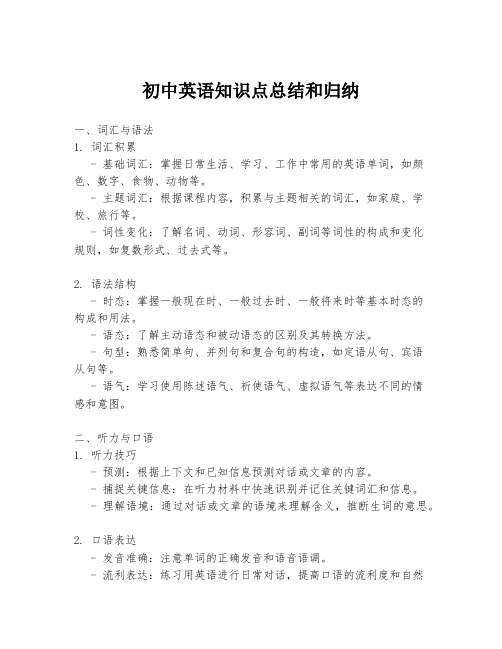
初中英语知识点总结和归纳一、词汇与语法1. 词汇积累- 基础词汇:掌握日常生活、学习、工作中常用的英语单词,如颜色、数字、食物、动物等。
- 主题词汇:根据课程内容,积累与主题相关的词汇,如家庭、学校、旅行等。
- 词性变化:了解名词、动词、形容词、副词等词性的构成和变化规则,如复数形式、过去式等。
2. 语法结构- 时态:掌握一般现在时、一般过去时、一般将来时等基本时态的构成和用法。
- 语态:了解主动语态和被动语态的区别及其转换方法。
- 句型:熟悉简单句、并列句和复合句的构造,如定语从句、宾语从句等。
- 语气:学习使用陈述语气、祈使语气、虚拟语气等表达不同的情感和意图。
二、听力与口语1. 听力技巧- 预测:根据上下文和已知信息预测对话或文章的内容。
- 捕捉关键信息:在听力材料中快速识别并记住关键词汇和信息。
- 理解语境:通过对话或文章的语境来理解含义,推断生词的意思。
2. 口语表达- 发音准确:注意单词的正确发音和语音语调。
- 流利表达:练习用英语进行日常对话,提高口语的流利度和自然度。
- 情景对话:通过模拟不同的生活场景,练习相关的口语表达和交流技巧。
三、阅读与写作1. 阅读理解- 快速阅读:通过快速阅读抓住文章的主旨大意。
- 细读理解:细致阅读文章,理解细节信息和作者的观点。
- 推理判断:根据文章内容进行逻辑推理,做出合理的判断和结论。
2. 写作技巧- 文章结构:学习如何组织文章,包括引言、正文和结尾。
- 语言表达:使用恰当的词汇和句型表达思想,注意语法的正确性。
- 写作风格:了解不同文体的写作特点,如叙述文、说明文、议论文等。
四、文化与交际1. 文化知识- 了解英语国家的基本文化习俗和社会行为规范。
- 学习与英语相关的背景知识,如节日、历史、文学等。
2. 交际能力- 礼貌用语:掌握日常交际中的礼貌用语,如问候、感谢、道歉等。
- 情感表达:学会用英语表达喜怒哀乐等情感。
- 合作交流:在小组活动中与他人合作,练习英语交流和解决问题的能力。
九年级英语重点知识点总结

九年级英语重点知识点总结一、语法知识点1. 被动语态- (1)构成:一般现在时的被动语态:am/is/are+过去分词;一般过去时的被动语态:was/were+过去分词;一般将来时的被动语态:will be+过去分词;含有情态动词的被动语态:情态动词+be+过去分词。
- (2)用法:强调动作的承受者。
例如:The bridge was built last year.(这座桥是去年建造的。
)2. 定语从句- (1)关系代词:who(先行词指人,在从句中作主语或宾语),whom(先行词指人,在从句中作宾语),which(先行词指物,在从句中作主语或宾语),that(先行词指人或物,在从句中作主语或宾语)。
例如:I like the bookwhich/that was written by Lu Xun.(我喜欢鲁迅写的那本书。
)- (2)关系副词:when(先行词表示时间,在从句中作时间状语),where (先行词表示地点,在从句中作地点状语),why(先行词为reason,在从句中作原因状语)。
例如:I still remember the day when we first met.(我仍然记得我们第一次见面的那一天。
)3. 宾语从句- (1)语序:宾语从句要用陈述句语序。
例如:He asked me where I was from.(他问我来自哪里。
)- (2)时态:主现从不限;主过从必过;客观真理用一般现在时。
例如:She says that she will go to Beijing tomorrow.(她说她明天将去北京。
);He said that he had seen the movie.(他说他已经看过这部电影了。
);The teacher told us that the earth goes around the sun.(老师告诉我们地球绕着太阳转。
)4. 情态动词- (1)must:表示必须,肯定推测(用于肯定句,意为“一定”)。
初中英语总复习知识点归纳(基本全了)
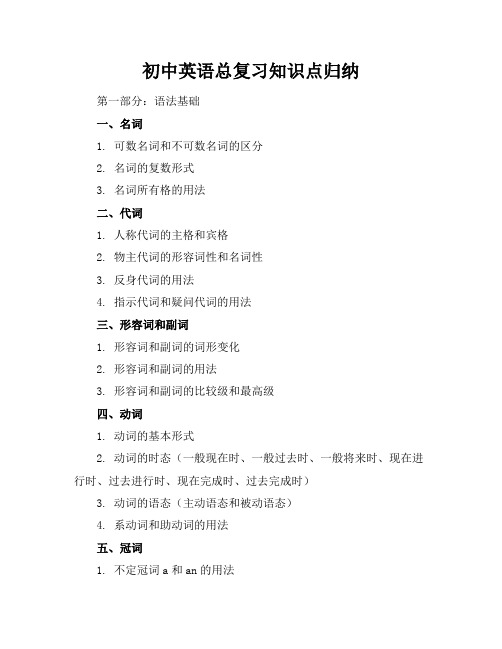
初中英语总复习知识点归纳第一部分:语法基础一、名词1. 可数名词和不可数名词的区分2. 名词的复数形式3. 名词所有格的用法二、代词1. 人称代词的主格和宾格2. 物主代词的形容词性和名词性3. 反身代词的用法4. 指示代词和疑问代词的用法三、形容词和副词1. 形容词和副词的词形变化2. 形容词和副词的用法3. 形容词和副词的比较级和最高级四、动词1. 动词的基本形式2. 动词的时态(一般现在时、一般过去时、一般将来时、现在进行时、过去进行时、现在完成时、过去完成时)3. 动词的语态(主动语态和被动语态)4. 系动词和助动词的用法五、冠词1. 不定冠词a和an的用法2. 定冠词the的用法3. 不使用冠词的情况六、连词1. 并列连词的用法2. 从属连词的用法七、介词1. 常用介词的用法2. 介词短语的结构和用法八、数词1. 基数词和序数词的用法2. 分数、小数和百分数的表达九、感叹词1. 感叹词的用法十、疑问词1. 疑问词的用法十一、句型结构1. 简单句的五种基本句型2. 并列句和复合句的结构和用法十二、主谓一致1. 主谓一致的原则2. 主谓一致的特殊情况十三、倒装句1. 完全倒装和部分倒装的区别2. 常见的倒装句型十四、省略句1. 省略句的结构和用法十五、强调句1. 强调句的结构和用法十六、虚拟语气1. 虚拟语气的用法十七、情态动词1. 情态动词的用法十八、非谓语动词1. 非谓语动词的分类和用法十九、固定搭配1. 常见的固定搭配二十、习惯用语和俚语1. 常见的习惯用语和俚语第二部分:词汇与短语一、词汇记忆方法1. 词根词缀记忆法2. 同义词和反义词记忆法3. 分类记忆法4. 联想记忆法二、常见词汇和短语1. 常用动词短语2. 常用形容词短语3. 常用介词短语4. 常用连词短语5. 常用固定搭配三、词汇辨析1. 形近词辨析2. 意思相近的词辨析3. 语境辨析四、词汇应用1. 词汇在句子中的应用2. 词汇在段落中的应用3. 词汇在文章中的应用五、词汇扩展1. 通过阅读扩展词汇2. 通过听力扩展词汇3. 通过口语和写作扩展词汇六、词汇复习策略1. 制定词汇复习计划2. 定期进行词汇测试3. 反复记忆和复习第三部分:阅读理解一、阅读技巧1. 快速阅读2. 精读3. 猜词技巧4. 理解文章主旨和大意5. 找出文章中的细节信息二、阅读题型1. 主旨大意题2. 细节理解题3. 推理判断题4. 词义猜测题5. 观点态度题三、阅读材料1. 故事类文章2. 议论文3. 说明文4. 应用文5. 新闻报道四、阅读理解策略1. 预览文章和首段2. 扫读文章找出关键词3. 仔细阅读理解文章内容4. 回答问题时注意关键词和语境5. 验证答案是否符合文章内容第四部分:写作技能一、写作技巧1. 确定写作目的和主题2. 拟定写作提纲3. 运用适当的句型和词汇4. 保持文章逻辑清晰5. 注意文章格式和标点符号二、写作题型1. 记叙文2. 议论文3. 说明文4. 应用文5. 日记和书信三、写作素材1. 人物描写2. 地点描写3. 事件描写4. 情感表达5. 观点陈述四、写作策略1. 多读优秀范文2. 多练习写作3. 请教老师和同学4. 反复修改和润色5. 保持写作兴趣和热情第五部分:听力理解一、听力技巧1. 预测听力内容2. 抓住关键词和关键信息4. 边听边记笔记5. 理解对话和独白的逻辑关系二、听力题型1. 简单听力理解题2. 听力细节理解题3. 听力推理判断题4. 听力主旨大意题5. 听力词义猜测题三、听力材料1. 对话2. 独白3. 新闻报道4. 广播节目5. 电影和电视剧片段四、听力理解策略1. 预览问题和选项2. 仔细听录音,注意关键词3. 根据听力内容进行推理和判断4. 选择最符合听力内容的答案5. 检查答案是否符合题意第六部分:口语表达一、口语技巧1. 准备话题和内容3. 保持语速适中4. 注意语法和词汇的准确性5. 保持自信和流畅二、口语题型1. 自我介绍2. 话题讨论3. 角色扮演4. 观点陈述5. 回答问题三、口语素材1. 日常生活话题2. 学校生活话题3. 社会热点话题4. 个人兴趣爱好话题5. 旅游和文化话题四、口语表达策略1. 多听多说,提高口语能力2. 模仿优秀的口语表达3. 与老师和同学进行口语练习4. 参加英语角和口语比赛5. 记录自己的口语表达,进行反思和改进第七部分:综合技能一、综合技巧1. 综合运用语法、词汇、阅读、写作、听力和口语等技能2. 注重语言的实际运用能力3. 提高语言的综合运用水平4. 培养跨文化交际能力5. 保持学习英语的兴趣和动力二、综合题型1. 完形填空2. 阅读理解3. 写作4. 听力理解5. 口语表达三、综合复习策略1. 制定综合复习计划2. 定期进行综合测试3. 反复练习和复习4. 请教老师和同学5. 保持学习英语的兴趣和热情。
初中英语最全知识点

初中英语最全知识点一、语法知识点1. 词类及词性转换:名词、动词、形容词、副词、代词、介词、连词、数词、冠词、感叹词等。
2. 时态:一般现在时、一般过去时、一般将来时、现在进行时、过去进行时、过去将来时、现在完成时、过去完成时等。
3. 句子结构:肯定句、否定句、疑问句、祈使句、感叹句,以及简单句、并列句、复合句等。
4. 语态:主动语态和被动语态的形式和用法。
5. 名词性从句:宾语从句、主语从句、表语从句和同位语从句的用法。
6. 倍数和比例:倍数、百分数、小数、比例关系的表示和计算方法。
二、词汇知识点1. 同义词与反义词:常用词的近义词与反义词,以及其用法和辨析。
2. 词组和短语:常见的固定搭配、短语动词以及习惯用语的应用。
3. 同音词与同形词:词汇中常见的同音词和同形词的区别和使用。
4. 常见形容词与副词:形容词和副词的形式与用法,常见程度副词的比较级和最高级等。
三、阅读理解知识点1. 主旨大意:通过概括段落或全文,抓住文章的主要意义。
2. 猜词义:通过上下文理解词语的含义。
3. 事实细节:从文章中找出具体的事实和细节。
4. 推理判断:根据已有信息进行推理和判断。
5. 文章结构:理解文章的组织结构,如时间顺序、因果关系等。
四、写作知识点1. 书信写作:包括写信的格式、信件内容和写作技巧等。
2. 日记写作:日记的格式、时间、地点、人物、事件等的描述。
3. 叙述文写作:描述事物、人物或事件的顺序、空间、人物心理等。
4. 说明文写作:对某一事物或概念进行解释、描述或介绍。
5. 议论文写作:陈述观点、论证理由、对比分析等。
五、听力技巧1. 匹配题:根据听力内容进行选项匹配。
2. 选择题:根据听到的信息进行选择。
3. 填空题:根据听到的内容填写所需信息。
4. 判断题:根据听到的内容进行真假判断。
5. 句子听写:听写完整句子或短文段落。
以上是初中英语最全的知识点总结,涵盖了语法、词汇、阅读理解、写作以及听力技巧等方面。
初中英语最全知识点
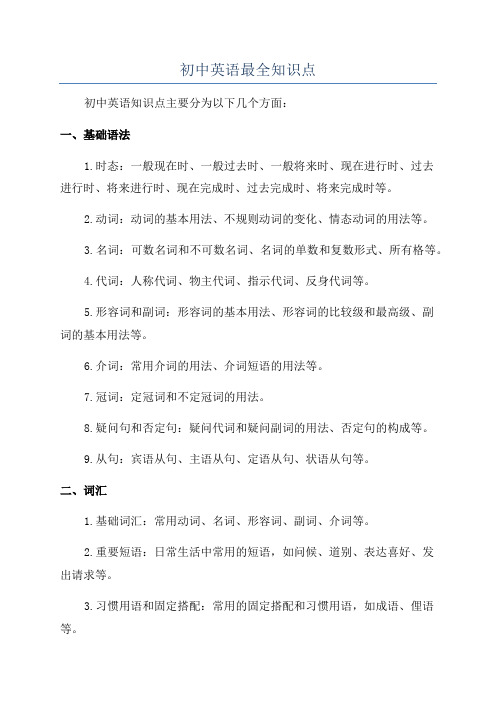
初中英语最全知识点初中英语知识点主要分为以下几个方面:一、基础语法1.时态:一般现在时、一般过去时、一般将来时、现在进行时、过去进行时、将来进行时、现在完成时、过去完成时、将来完成时等。
2.动词:动词的基本用法、不规则动词的变化、情态动词的用法等。
3.名词:可数名词和不可数名词、名词的单数和复数形式、所有格等。
4.代词:人称代词、物主代词、指示代词、反身代词等。
5.形容词和副词:形容词的基本用法、形容词的比较级和最高级、副词的基本用法等。
6.介词:常用介词的用法、介词短语的用法等。
7.冠词:定冠词和不定冠词的用法。
8.疑问句和否定句:疑问代词和疑问副词的用法、否定句的构成等。
9.从句:宾语从句、主语从句、定语从句、状语从句等。
二、词汇1.基础词汇:常用动词、名词、形容词、副词、介词等。
2.重要短语:日常生活中常用的短语,如问候、道别、表达喜好、发出请求等。
3.习惯用语和固定搭配:常用的固定搭配和习惯用语,如成语、俚语等。
三、听力技巧1.听懂关键信息:根据问题的关键词,听取和理解相关信息。
2.推理判断:通过对对话或短文的整体理解和背景知识,推断出正确的答案。
3.注意细节:注意听取细节信息,如数字、时间、地点等。
四、阅读技巧1.阅读理解:理解文章的主旨、推理判断、细节理解等。
2.理解文章结构:理解文章的段落结构和逻辑关系。
3.查找信息:根据问题查找文章中的相关信息。
4.推断词义:通过上下文推断生词的意思。
五、写作技巧1.书信写作:根据指定的写信格式和要求,写一封书信。
2.作文写作:写一篇短文,描述或讨论一个话题。
六、口语交际1.日常交际用语:问候、道别、求助、表示喜好等。
2.情景对话:根据给定的情景,进行实际对话。
七、常用短语和习惯用语1.日常生活中常用的短语和习惯用语,如问路、购物、旅行等。
八、文化知识1.英语国家的风俗习惯、节日等。
以上是初中英语知识点的一个大致分类和总结,具体的知识点可能更加详细和具体。
初中英语教师资格证面试备考-初中英语语法点汇总七年级

初中英语教师资格证面试备考-初中英语语法点汇总七年级七年级上册 (2)动词be的一般现在时 (2)行为动词的一般现在时 (2)人称代词 (4)表示时间的介词(in/on/at) (5)特殊疑问句 (5)可数名词与不可数名词 (6)用some和any表示数量 (8)There be结构 (9)现在进行时 (9)七年级下册 (10)基数词 (10)序数词 (11)一般将来时(will/shall) (12)一般将来时(be going to) (13)名词所有格 (14)形容词性物主代词和名词性物主代词 (14)冠词a/an/the (15)方位介词 (16)一般过去时 (17)情态动词can/could/may (18)What/How感叹句 (19)形容词 (20)不定代词 (20)七年级上册动词be的一般现在时Simple present tense of the verb to beWe use the simple present tense to talk about facts and states.We make positive and negative sentences using the verb to be in the simple present tense like this:We ask and answer questions using the verb to be in the simple present tense like this:行为动词的一般现在时Simple present tense of the verb to doWe use the simple present tense when we talk about:1.things that we often doMillie gets up at6:30Cats eat fish.Simon likes playing every morning.2.things that are always trueCats eat fish.3.things that are true nowSimon likes playing football.We make positive and negative sentences using the verb to do in the simple present tense like this:We ask and answer questions using the verb to do in the simple present tense like this:Remember that we add-s to the verb after he,she or it.However,there are some exceptions:We change have to has when it comes after he,she or it.I have a ball.She has a ball.人称代词Personal pronouns(subject form)We can use personal pronouns to replace nouns for people or things,so we do not need to repeat the nouns.We use the subject form when the noun is the subject.表示时间的介词(in/on/at)Prepositions of timeWe use different prepositions to talk about time.特殊疑问句Asking wh-questionsWe use wh-questions to ask for information about someone/something.可数名词与不可数名词Countable and uncountable nounsA countable noun refers to something we can count.Here are some examples.We use a or an before a singular countable noun.If the noun starts with a vowel sound, we use an.To form the plural of most countable nouns,we add-s to the singular form.However, there are some exceptions.用some和any表示数量Using some/anyWe use some or any to talk about the amount of something.Positive sentence:They have some money.Negative sentence:They don’t have any money.Question:Do they have any money?Tip:We can use some in questions when we are making offers and requests.We use it when we expect the answer to be“yes”.Would you like some tea?Can I have some oranges?There be结构Using there beWe use there be to show that something exists.We use there is before a singular noun or an uncountable noun.We use there are before a plural noun.现在进行时Present continuous tenseWe use the present continuous tense to talk about things that are happening now.We make positive and negative sentences using the present continuous tense like this:The table below shows how we make the-ing form of a verb.七年级下册基数词Cardinal numbersWe use cardinal numbers almost every day.We use them to talk about the numbers of people or things.How do we say the following numbers?4,056=four thousand and fifty-six23,813=twenty-three thousand eight hundred and thirteen567,110=five hundred and sixty-seven thousand one hundred and ten6,425,200=six million four hundred and twenty-five thousand two hundred序数词Ordinal numbersWe use ordinal numbers to order things and events.We use them to talk about dates, floors,positions,etc.Women’s Day is on the eighth of March.Our flat is on the seventh floor.He is always the first to come to school in our class.一般将来时(will/shall)Simple future tense with will and shallWe use will or shall when we talk about1things that are sure to happen in the future:It will rain this afternoon.2plans that we are making now:I will take an umbrella with me.We make positive and negative sentences using the simple future tense like this:We ask and answer questions using the simple future tense like this:一般将来时(be going to)Simple future tense with be going toWe use be going to when we talk about1something we decide to do:I am going to visit our new neighbours.She is going to watch the film next Friday.2things that will probably happen:It is nine o’clock.We are going to be late.It is so cloudy.I think it is going to rain.We ask and answer questions with be going to like this:名词所有格Noun+’s1We usually add’s to a singular noun to express the idea of belonging.I would like to take the boys to our school’s football field.2We add’to a plural noun ending in-s.The exchange students’homes are in the UK.3We add’s to plural nouns that do not end in-s.children’s people’s men’s women’s4We often use’s with names.Neil’s mother is calling him from the UK.形容词性物主代词和名词性物主代词Possessive adjectives and pronounsWe use possessive adjectives and pronouns to express the idea of belonging. There are lots of nice shops in our town.An old friend of mine is coming to see me.冠词a/an/theUsing a,an and theWe use a or an when we mention a person or thing for the first time.We use the before a noun when the person or thing is mentioned again,or when we are talking about a specific person or thing.Prepositions of placeWe use prepositions of place to say where things or people are.The flowers are in front of the shop.The trees are behind the shop.The shopkeeper is inside the shop.The boy is outside the shop.The food is above the drinks.The drinks are below the food.The sign is over the bench.The dog is under the bench.Simple past tenseWe use the simple past tense to talk about things in the past.A month ago,Millie and Amy went to Sunshine Park.Last Sunday,they went to the park again.We form the simple past tense by adding-ed to regular verbs.We form the simple past tense of irregular verbs differently.We do not add–ed.We use the simple past tense to make positive and negative sentences like this:We use the simple past tense to ask and answer questions like this:情态动词can/could/mayUsing can,could and mayWe use can or could to talk about ability.We use can to talk about present ability and use could to talk about ability in the past.Millie can speak good English.Shirley cannot ride a horse.The old man could swim across the Yangtze River.2We use can,could or may to ask for permission.Could sounds more polite than can.May is formal.—Can I borrow your bike,Millie?—Yes,you can.Here you are.—Could I smoke here?—Sorry,I’m afraid you can’t.—May I use your mobile phone?—Of course you may.What/How感叹句Using What and How to express strong feelingsWe use What...!or How...!in a short phrase to express strong feelings about someone or something.How dangerous!What a brave man!We make sentences with What...!and How...!like this:形容词Using adjectivesWe use adjectives to describe people or things.We can put an adjective before a noun or after a linking verb.Rabbits have long ears.Rabbits’ears are long.A lazy cat is sleeping on the sofa.The cat on the sofa is lazy.不定代词Indefinite pronounsWe use indefinite pronouns to refer to people and things when we do not know or donot need to mention who or what we are talking about.1We use somebody,someone and something in positive sentences.I saw somebody/someone/something in the house.Tip:When we are offering something or when we expect the answer to be“yes”,we can use something/somebody/someone in questions.Would you like something to eat?Is someone there?2We use anybody,anyone and anything in negative sentences or in questions.I did not see anybody/anyone/anything in the house.Did you see anybody/anyone/anything in the house?3We use nobody,no one and nothing to refer to“not anyone”and“not anything”.There is nobody/no one/nothing in the house.4We use everybody,everyone and everything to refer to“all people”and“all things”.Is everybody/everyone here today?Everything is ready.。
初中英语教师资格证考点汇总

初中英语教师资格证考点汇总文档简介本文档汇总了初中英语教师资格证考试的主要考点和内容要点,帮助考生更好地备考和掌握考试重点。
考试内容概述初中英语教师资格证考试主要测试考生在英语教学方面的知识和能力。
考试包括语言知识与能力、教育教学知识与能力和专业知识与能力三个部分。
语言知识与能力词汇与语法- 常用单词和词组- 基本语法知识- 情态动词的用法- 动词时态和语态- 名词、代词、形容词和副词的基本用法句型与篇章- 常用句型和短语- 句子结构和语法规则- 阅读理解和写作技巧教育教学知识与能力教育心理学- 研究理论与教育心理学原理- 学生发展特点和心理需求- 教学中的评价与反馈教学设计与评价- 教学目标和内容的设计- 不同教学方法的应用- 教学评价和教育研究方法教学组织与管理- 教学组织与班级管理- 学科教学与综合实践活动的组织- 学校教育改革和教学发展的趋势专业知识与能力英语教育基础- 英语教学理论- 英语教材与教学方法- 外语教育研究与教学改革英语教学实践- 教学设计与实施- 教学材料和教具的选择与应用- 多媒体技术在英语教学中的应用考试准备建议- 熟练掌握常用单词和词组,加强词汇积累- 熟悉基本语法知识,掌握常见句型和语法规则- 注重阅读理解和写作训练,提高语言表达能力- 研究教育心理学知识,了解学生发展特点和教学评价方法- 针对专业知识与能力部分,研究相关教育理论和教学改革动向> 注意:本文档总结了初中英语教师资格证考试的主要考点和内容要点,但具体的考试内容以官方发布的考试大纲为准。
考生在备考过程中应结合大纲进行综合复习和准备。
初中英语知识点总结教资

初中英语知识点总结教资一、词汇与语法1. 词汇积累- 基础词汇:掌握日常生活中常用的名词、动词、形容词、副词、介词等。
- 主题词汇:根据课程内容,学习与学校生活、家庭、职业、食物、交通等相关的词汇。
- 词性转换:了解名词、动词、形容词之间的转换规则,如动词+ing构成动名词,形容词+ly构成副词等。
2. 语法结构- 时态:掌握一般现在时、一般过去时、一般将来时等基本时态的构成和用法。
- 句型:学习肯定句、否定句、疑问句的构造,以及简单句、并列句的运用。
- 语态:区分主动语态和被动语态,了解其构成和用法。
- 非谓语动词:学习动名词、分词(现在分词和过去分词)的用法。
- 情态动词:掌握can, could, may, might, must, should等情态动词的基本用法。
二、阅读理解1. 阅读技巧- 快速阅读:通过扫读(skimming)和略读(scanning)技巧,快速获取文章大意和具体信息。
- 精读理解:细致阅读文章,理解句子结构和文章内容,把握作者意图和文章主旨。
2. 题型解析- 细节理解题:通过定位法找到文中相关信息,准确把握细节。
- 主旨大意题:抓住文章标题、首尾段落和主题句,理解文章中心思想。
- 推理判断题:根据文章内容进行逻辑推理,推断隐含信息。
三、写作技巧1. 文章结构- 开头:引入话题,提出观点或描述情境。
- 正文:分段论述,每段明确中心句,提供支持细节。
- 结尾:总结全文,重申观点或提出建议。
2. 写作类型- 描述性写作:描述人物、地点、事件等,使用形象生动的语言。
- 叙述性写作:叙述故事或经历,注意时态和顺序。
- 议论性写作:提出观点,给出理由和例证,进行逻辑论证。
四、听力训练1. 听力技巧- 预测:根据题目和图片信息预测对话或短文内容。
- 注意力集中:专注于听力材料,捕捉关键信息。
- 笔记:记录重要信息,帮助理解和记忆。
2. 听力题型- 对话理解:理解对话双方的意图和态度。
初中英语必考知识点总结
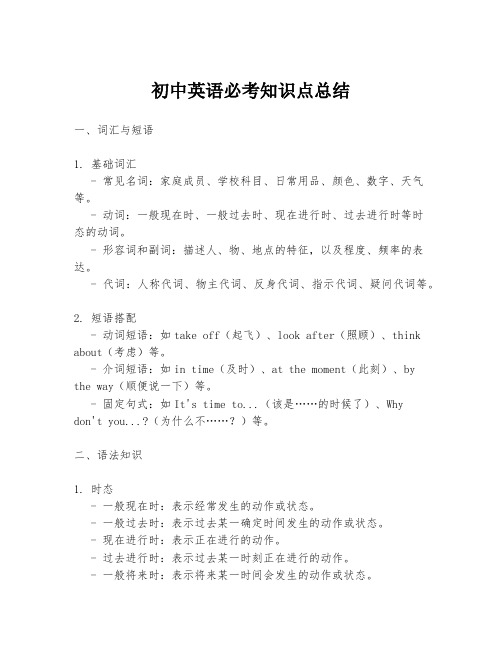
初中英语必考知识点总结一、词汇与短语1. 基础词汇- 常见名词:家庭成员、学校科目、日常用品、颜色、数字、天气等。
- 动词:一般现在时、一般过去时、现在进行时、过去进行时等时态的动词。
- 形容词和副词:描述人、物、地点的特征,以及程度、频率的表达。
- 代词:人称代词、物主代词、反身代词、指示代词、疑问代词等。
2. 短语搭配- 动词短语:如take off(起飞)、look after(照顾)、think about(考虑)等。
- 介词短语:如in time(及时)、at the moment(此刻)、by the way(顺便说一下)等。
- 固定句式:如It's time to...(该是……的时候了)、Whydon't you...?(为什么不……?)等。
二、语法知识1. 时态- 一般现在时:表示经常发生的动作或状态。
- 一般过去时:表示过去某一确定时间发生的动作或状态。
- 现在进行时:表示正在进行的动作。
- 过去进行时:表示过去某一时刻正在进行的动作。
- 一般将来时:表示将来某一时间会发生的动作或状态。
2. 语态- 被动语态:表示动作的承受者成为句子的主语。
- 常见时态的被动语态形式。
3. 非谓语动词- 动名词:作为名词使用,可以作主语、宾语等。
- 分词:现在分词和过去分词,用作形容词或副词。
- 不定式:作为名词、形容词、副词等使用。
4. 句子结构- 简单句:只有一个主语和谓语的句子。
- 并列句:由两个或多个简单句通过并列连词连接而成。
- 复合句:包含主句和从句的句子,从句可以是名词性从句、定语从句或状语从句。
5. 特殊句式- 倒装句:在某些特定条件下,句子的主语和谓语可以颠倒。
- 省略句:在某些情况下,句子中的某些成分可以省略。
三、阅读理解1. 快速阅读- 通过扫读(Skimming)和查读(Scanning)快速获取文章大意和细节信息。
2. 细节理解- 理解文章中具体的事实和细节,包括数字、时间、地点等。
初中教资面试-词汇知识点+英文解释

英语教师资格证面试---初中词汇课试讲初中组:这段材料旨在让学生学习所给单词的拼写,语用和搭配,找到重点后就可以根据材料来设计课堂了。
以下是我自己在面试时用到的讲稿,讲稿是我提前写好的一个模板,我提前背熟,抽到类似题目,替换一下词汇就可以用了。
试讲稿Step 1: Warming up(5mins)Hello, every one, I’m xxx-, it’s my honor to have this opportunity to participate this interview. Now i will begin my class.Good afternoon boys and girls, (声音要洪亮些!笑脸露出来,打起12分精神,给考官第一印象很重要!!)Nice to see you,how are you today? (开场寒暄很重要)Ok, i would like to introduce myself, I am Miss Chan, today we will learn English together,Step 2: Pre-reading (5mins)Today our topic is about robot, let’s see a short video about robot(假装看着屏幕,电影可以导入今日所学的内容,激发他们学习兴趣。
)Step 3: While-reading (20mins)I will read this paragraph to you,and please circle the new words .(这时就可以读文章,读文章是要自信,大声,发音要标准,好的发音会给你加不少分!!) Now Read the whole paragraph quickly and tell me the meaning of “possible”and “probably”,you can discuss with your desk mate.Ok, who can tell us what are the meanings of these two words?Lily? Ok, she said the synonym of these two words is maybe.Yes, when you use probably ,it means the thing is likely to be true. Its synonym is maybe,likely.Now please use this word to make a sentence, who want to be a volunteer?2. Detailed reading (15mins):Now ,please scan the following questions,read the paragraph again carefully and answerQ: Why will people have less work to do?Q: What will robot look like in the future?Discuss in group of 4 and i will ask someone to share your answers.Step 4: Post-reading (10mins)1. Give them further information about the key words.2. Ask students to have a group discussion. List the advantage and the disadvantage of robot.Step 5: Summary & Homework (5mins)1.Ask students to summarize the main idea of this paragraph2. After class, please search some information about robot.词汇部分知识点1.构词法Word-formationIf you meet the new words while reading comprehension, what will you do? You can guess the meaning according the formation of the word.词根Root: all words contain root morpheme.词干Stem: root+suffix词缀Affix: prefix, infix,suffixGrammatical morpheme:-s,-ed,-ing,-s,-estDerivation morpheme: un-,-less,dis-复合词Compound2 words join to produce 1 word.Ice-cream, railway,wedding-ring,color-blind,sleep-walk派生词Derivation:Shows relation between root and affixDis like,un happy,speechless,foolishUnemployment, unableDisagree,disappearIncorrect,impossible,irregular后缀Suffix that can form noun-er,-ese,-ist,-tion,-ment,-ian,-nessBuyer,Chinese,physicist, collection,happiness, development,musician形容词Adj:Ful,ing,less,al,,anNationalBeautifulSpeechlessAmerican动词Verb:Fy,izeBeautifyRealize副词Adv-lyTrans-acrossCo-togetherVis-seeSub-belowBio-lifeGuess the meaning of the word:He study biophysics at college.Lexical change词汇变化1.混成法BlendingFirst part of first word,and last part of second word Smoke+fog=smog.首字母缩写AcronymUnited nation=UN3.缩写法ABBREVIATION:Advertisement=4.借用BORROWING:Tofu,sofa押韵Alliteration头韵End rhyme 尾韵。
教师资格证英语知识点

教师资格证英语知识点【篇一:教师资格证英语知识点】吕媛媛在国考教师资格证中,简答题的分值为20分,考查范围也较广泛,很多考生觉得难以着手准备,本文梳理近几年的简答题出题形式并总结梳理必备知识点,以期为考生复习备考提供参考。
一、真题再现1. 课堂导入是初中英语课堂教学常用步骤之一。
以课文“christmas”为例,写出四种常见的导入方法并各举一例说明。
(2013年下半年初中英语学科知识与教学能力试题简答题)2. 课堂教学目标的设定通常需要关注四个要素:who, will do what, under what conditions, to what degree。
请根据上述四个要素简述下列教学目标存在的问题(12分),并改写该教学目标。
(8分)teaching objectives:enable students to talk about festivals and customs in english and express or support an opinion with suitable expressions.(2012年下半年高中英语简答题)3. 简述课文教学“导入”活动的目的和注意事项,并以“talking about likes and dislikes”为例,用英文写出两句相应的课堂导入语(2014年上半年初中英语简答题)4. 请简述教师课堂上“创设语境”需要考虑的基本要素(8分),并举例说明具体的教学手段(12分)。
(2014年下半年初中英语简答题)5. 课堂提问的作用是什么?(8分)封闭性问题与开放性问题各自有什么特点?(12分)(2014年上半年高中英语简答题)二、考点梳理简答题的出题范围较广,主要考察了对课堂教学相关理念的理解,包括教学目标、教学技能、教学片断等方面,教学目标和教学片断技能的考核主要体现在教学设计中(和教学设计题型的复习可以互相借鉴),本文将重点梳理和教学技能相关的基本理念。
- 1、下载文档前请自行甄别文档内容的完整性,平台不提供额外的编辑、内容补充、找答案等附加服务。
- 2、"仅部分预览"的文档,不可在线预览部分如存在完整性等问题,可反馈申请退款(可完整预览的文档不适用该条件!)。
- 3、如文档侵犯您的权益,请联系客服反馈,我们会尽快为您处理(人工客服工作时间:9:00-18:30)。
第一部分语言知识与能力第一章英语语言知识二、语音(Speech Sounds)P781、语音分类发音方式发音部位VL - 清浊音(voiceless consonant)VD - 浊辅音(voiced consonant)2、音系学(phonology)P79(1)同化规则(assimilation Rule)progressive assimilation 顺同化(前面带偏后面)workedregressive assimilation 逆同化(后面带偏前面)newspaperreciprocal/double assimilation 互相同化did you(2)音节(syllable)tea chi-na im-pos-si-ble重音(stress)声调(tone)(3)语音变化(vocal variety)liaison 连读pick it upplosion 爆破音plosion loss 失去爆破sit down ;incomplete plosion 不完全爆破ask ednasal plosion 鼻腔爆破button ;lateral plosion 舌边爆破little三、形态学(Morphology)1、morpheme 词素重点!P87(1)free morpheme 自由词素dog ;bound morpheme 黏着词素moonwalk(2)root 词根;affix 词缀(prefix 前缀、suffix 后缀);stem 词干friend-ships (3)inflectional affix 屈折词缀-s,-ing,-ed不同形式(4)derivational affix 派生词缀改变词性和意义2、(1)inflection 屈折变化-s,-ing,-ed不同形式(2)word-formation 词的形成:compounding 复合法through-outderivation 派生法(prefixation 前缀化suffixation 后缀化)il-logical-ly3、常见构词法P89invention 新创词nylon ;blending 混成法smoke+fog=smogclipping 截断法advertisement=ad ;initialism 首字母连写词WTOacronym 首字母拼音词AIDS ;back-formation 逆构词法editor--editanalogical creation 类似构词work--wrought/workedtypes of borrowing 借词法:loanword/borrowing 借词feast(法语中借来)loanblend 混合借词Chinatown (本国加外来)loanshift 转移借词bridge (借用意义)loan translation 翻译借词(从别种语言翻译而来)4、词义变化broadening 词义扩大bird 小鸟--鸟类;narrowing 词义缩小girl 年轻人--女孩meaning shift 词义转移;class shift 词性转换;folk etymology 俗词源(错多了成了对的)四、句法学(Syntax)P911、句法关系syntagmatic relation 组合关系(horizontal relation/chain relation)构成同一形式、序列或结构paradigmatic relation 聚合关系(vertical relation/choice relation)各要素可相互替换relation of co-occurrence 共现关系(不同集合的词语一起组成句子)2、句子结构和成分immediate constituent analysis 直接成分分析法(IC分析法)The boy ate the apple. 用树形图(tree diagram)一般句子,主谓宾之类的endocentric construction 向心结构一个词或词组可以确定为中心(center)或中心词(head)two stone bridge 一般名词/动词/形容词短语exocentric construction 离心结构没有确定的中心或中心词The boy smiled. 一般动宾/系表结构deep structure 深层结构(含义相同,说法不同)surface structure 表层结构(句子表述方式)五、语义学(Semantics)P931、涵义关系(Sense Relations)lexical relation 词汇关系(1)同义关系(Synonymy)synonyms 同义词stylistic 文体差别(formality) buy--perchase ;dialectal 地域差别underground--subway collocational 搭配差别accuse(of)--charge(with) ;emotive 情感差别thrifty--stingy ;semantic 语义差别enough--ample(2)反义关系(Antonymy)antonyms 反义词relational opposites 意义相反词gradable antonymy 等级反义warm--coolcomplementary antonymy 互补反义boy--girlconverse antonymy 反向反义关系buy--sell(3)上下义关系(Hyponymy)种类和成员包括上坐标词(superordinate)和下义词(hyponymy)flower--rose/tulip(4)一词多义(Polysemy)(5)同音/同形异义现象(Homonymy)homophone 同音异义sun--sonhomograph 同形异义liecomplete homonym 完全同音同形异义bank 岸边;银行2、句子逻辑关系iff--充分必要条件“S is true iff P”P就是S的真值条件(truth condition)P (1)synonymy 同义关系“X is synonymous with Y.”同真同假P95(2)contradiction 矛盾关系“X is inconsistent with Y.”一真一假(3)entailment 蕴含关系“X entails Y.”X小,Y大X:old man Y:man(4)presupposition 预设关系“X presupposes Y.”Y是前提X:repair the car Y:have a car六、语用学(Pragmatics)P961、言语行为理论(Speech Act Theory)(1)locutionary act 发话行为(说话人表达字面意思)is the act of saying something which is meaningful an can be understood. (2)illocutionary act 行事行为(说话人表达意图)is the act in saying something to perform a function.(3)perlocutionary act 取效行为(作用于听话人的效果)is the results or effects that are produced by means of saying something. 言外之意(illocutionary point):representatives 阐述类;directives 指令类;commissives 承诺类;expressives 表达类;declarations 宣告类2、会话含义理论(Conversational Principle/Maxim)violate 违反P97cooperative principle,CP 合作原则(会话有共同目标)“Make your conversational contribution such as is required, at the stage at which it occurs, by the accepted purpose or direction of the talk exchange in which you are engaged.”(1)the maxim of quantity数量准则(信息充分)(2)the maxim of quality质量准则(说实话)(3)the maxim of relation相关准则(说相关的事)(4)the maxim of manner方式准则(清楚简洁避免歧义)conversational implicature 会话含义(用会话准则暗示意义)(1)calculability 可推导性(含义能理解)(2)cancellability 可取消性(defeasibility)(因素变化,含义变化)(3)non-detachability 不可分离性(含义依附于内容)(4)non-conventionality非规约性(含义不确定)七、修辞学(Rhetoric)问法:rhetoric/rhetorical device 修辞策略P981、simile明喻like,as...as,as if,as though,similar to,such as2、metaphor隐喻(暗含比较)elephant pause3、personification拟人(把事物或概念当做人)4、metonymy借代(用事物的名称代替亲密相关的另一事物)5、synecdoche提喻(部分代替整体或整体代替部分)hand/mouth--man6、euphemism婉言die--pass away7、irony反语(意思相反)8、allegory讽喻9、exaggeration夸张(夸大或缩小使表达生动有趣)10、transferred epithet移位修辞nervous exam11、oxymoron矛盾修辞bitter-sweet memory12、pun双关语(homophonic puns 谐音双关;homographic puns 语义双关)八、语言教学P1001、中介语(interlanguage)2、对比分析(contrastive analysis)3、错误分析(error analysis)(1)error错误(因为知识不足)mistake失误(不注意犯错)(2)interlingual errors语际错误(迁移错误)因为母语Cnglishintralingual errors语内错误(发展性错误)因为过度概括语言规则eat-eated(错) 4、错误性质:omissions 省略(少成分);additions 添加(多成分);misformations 形式错误(eated);double markings 双重标记(didn’t went);misorderings 顺序错误(how you are)5、我国外语学习者错误类型(1)negative transfer 负迁移/干扰因为母语(2)over-generalization过度类推/过度概括因为过度概括语言规则(3)pragmatic failure语用错误违反对方的文化习俗6、第二外语习得理论(Second Language Acquisition,SLA)(1)Acquisition-Learning Hypothesis语言习得和学得假说(习得和学得两条不同的途径)(2)Monitor Hypothesis语言监察假说(学习者自己监督控制语言输出质量)(3)Input Hypothesis语言输入假说(接触理解可理解性语言输入comprehensible input)(4)Affective Filter Hypothesis情感过滤假说(输入input和吸收intake受到动力motivation、性格personality、情感状态affective state)(5)Natural Order Hypothesis自然顺序假说(可以不按任何语法顺序来教学)第二章英语语言运用能力一、教学中的非语言交际1、非语言手段P118environment language环境语(座位安排、时间信息、室内标示装饰、声音灯光等)object language客体语(个人,衣着化妆、个人用品等)2、非语言行为body language体态语(身姿、手势、表情、目光)paralanguage 副语言(声音音质、音量、语调、语速)第三章英语国家的语言、历史和文学三、语言、文化和社会1、局部结构P131毗邻对(adjacency pairs)一轮对话(1)毗邻对的条件相关性(conditional relevance)preferred second part/preference structure 优选结构Hidispreferred second part/dispreference structure 非优选结构relevant absence 相关缺失(2)毗邻对的扩展base pairs 根毗邻对(被其他会话扩展之前的毗邻对)前扩展,指前序列(pre-sequences),包括邀请、请求、结束、宣告中扩展,包括插入序列(insertion sequences)和旁侧序列(side sequences)后扩展,指后序列(post sequences),包括会话修正和主体化2、会话修正会话修正机制三个部分:修正源(trouble source)、修正的发起(repair initiation)、修正(repair)lexical 词汇启动(no,sorry,let me see,you know)non-lexical 非词汇启动(um..,uh..)四、语言与文字1、小说语言P134(1)小说与视角first-person narrator 第一人称叙述者(I)third-person narrator第三人称叙述者(he,she,it,they)(2)语言表达与思想表达direct speech 直接言语(“F**k you”)indirect speech间接言语(he said/asked)free indirect speech 自由间接言语第二部分语言教学知识与能力第一章初中英语课程标准一、初中英语课程基础知识1、英语课程的性质P149The nature of English Curriculum is instrumentality/tool and humanity.(工具性和人文性)Students’ overall development is the motivation and goal of the English curriculum.2、英语课程的设计思路The design of the new National English Curriculum unifies both primary and secondary school English into one continuum of development and divides English language teaching and learninginto nine competence-based levels by adopting the international general classification method. Level 5 is the required standard for the end of junior middle school. Level 2--primary school二、英语课程的分级标准P1541、语言技能(Language Skills)Overall performance objectives for each level are given in addition to detailed descriptions of abilities regarding language knowledge, language skills, affect, learning strategies as well as cultural awareness for relevant levels.2、语言知识(Language Knowledge)(语音、词汇、语法、功能和话题)Students are required to learn consists of phonetics, vocabulary, grammar, function and theme.3、情感态度(Affect)(兴趣、动机、自信、意志和合作精神;祖国意识和国际视野)interest, motivation, confidence, will and cooperation; National consciousness and international vision.4、学习策略(Learning Strategies)(认知、调控、交际、资源)Learning strategies can be classified into four groups: cognitive strategy, regulative strategy, communicative strategy and resourcing strategy.5、文化意识(Cultural Awareness/Understanding)(历史地理、风土人情、传统习俗、生活方式、行为规范、文学艺术、价值观念)Historical geography, local customs, traditional customs, lifestyle, norms of behavior, literature and art, values.三、英语课程的实施建议P1611、教学建议(1)面向全体学生,为每个学生学习英语奠定基础(2)注意语言实践,培养学生的语言运用能力(3)加强学习策略指导,培养学生自主学习能力(4)培养学生的跨文化交际意识,发展跨文化交际能力(5)结合实际教学需要,创造性地使用教材(6)合理利用各种教学资源,提高学生的学习效率(7)组织生动活泼的课外活动,拓展学生的学习渠道(8)不断提高专业水平,努力适应课程要求第二章初中英语教学基本理论一、语言观(Views of Language)P1731、语言的概念Language is a system of arbitrary vocal symbols used for human communication.2、语言的本质特征/设计特性(design features)(1)arbitrariness 任意性(体现了convention规约性)(2)duality 二重性(basic level, higher level基层和高层)(3)creativity 创造性/productivity能产性(4)displacement 移位性(赋予generalizations, abstractions概括和抽象)(5)cultural transmission 文化传习性3、语言的功能(Functions of Language)(1)informative function信息功能(2)interpersonal function人际功能(3)performative function施为功能(4)emotive function情绪功能(5)phatic function寒暄功能(6)recreational function娱乐功能(7)metalingual function元语言功能4、语言学角度的语言观(1)The Structural View of Language 结构语言观the structural view sees language as a linguistic system made up of various subsystems: phonology, morphology, lexicology and syntax.(2)The Function View of Language 功能语言观the function view sees language not only as a linguistic system but also as a means for doing things.(3)The Interactional View of Language 交互语言观(interaction, dynamics交互性和动态)the interactional view of language considers language as a communicative tool, whose main use is to build up and maintain social relations between people.二、语言学习观(Views of Language Learning)P1761、语言学习理论(1)Behaviorist Learning Theory 行为主义学习理论Behaviorism is an approach to psychology that arouses out of the ideas that attempted to explain all learning in terms of some form of conditioning (stimulus, response, and reinforcement)(2)Cognitive Learning Theory认知主义学习理论Cognitive theory thinks that “language is a intricate rule-based system and with a knowledge of the finite rules (language competence), infinite sentences can be produced”.(3)Constructivist Learning Theory构建主义学习理论The constructivist theory believes that learning is a process in which the learner constructs meaning based on his own experiences and what he already knows.最近发展区理论Zone of Proximal Development三、语言教学观(Views of Language Teaching)P1781、语言教学理论(结构主义教学理论、认知主义教学理论、社会语言学理论)四、外语教学法的主要流派1、grammar-translation method 语法翻译法2、audio-lingual method 听说法(pattern drill 句型操练、contrastive analysis对比分析法)3、total physical response 全身反应教学法P1814、cognitive approach 认知教学法(提高accuracy, appropriateness得体性)5、communicate approach 交际法(包含function,notion功能和意念)P183(1)交际能力(communicative competence)grammatical competence 语法能力、sociolinguistic 社会语言能力、discourse 语篇能力、strategic 策略能力、linguistic 语言能力、pragmatic语用能力、fluency流利性(2)3P教学模式:presentation--practice--production6、task-based approach任务型教学P184(1)real-world tasks /target tasks 目标任务;pedagogical tasks 教学任务(2)任务的四个构成元素:objective、context、process、outcome(3)information gap 信息差/信息沟activities must have clear and attainable objectives./should be confined to the classroom context./should help develop students’ language ability.(4)constructivism learning theory建构主义学习理论(强调scene, writing, conversation, and meaning construction情景、写作、会话和意义建构)(5)任务型教学的三个环节:pre-task前任务、task-cycle任务环(task、planning、report)、language focus语言聚焦(analysis、practice)第三章初中英语语言知识教学一、语音教学P1921、语音教学的内容The realistic goal of teaching pronunciation should be①consistency: the pronunciation should be smooth and natural.②intelligibility: the pronunciation should be understandable to the listeners.③communicative efficiency: the pronunciation should help convey the meaning that is intended by the speaker.2、Pronunciation knowledge teaching发音知识教学(monophonic, alphabet, phonetic symbols单音、字母、音标)3、Flow of language teaching语流教学(sounds, stress, rhythm, and intonation重音、节奏、语调)4、The principle of phonetic teaching语音教学的原则(accuracy, long-term, integrity, communication, pertinence, interest准确性、长期性、整体性、交际性、针对性、趣味性原则)5、The teaching method of phonetics语音的教学方法P195(1)Sound perception听音感知练习方法:using minimal pairs 最小对立体(live--leave)、which order 排序、same or different 辨别异同、odd one out 同中选异、completion 填空(2)Imitation and explanation 模仿讲解personally demonstration、imitate、practice亲自示范,反复模仿、练习(3)Pronunciation practice发音练习练习方法:listen and repeat 听音模仿、fill in the blanks 填空、using pictures 借助图片、using meaningful context 借助情景make up sentences 造句、using togue twisters运用绕口令(4)语流教学(见上)慢动作(slow motion speaking)二、词汇教学P197 language teaching theories 理论构成:receptive/passive vocabulary 接受性/消极词汇和productive/产出性/积极词汇1、Learning content教学内容(1)word meaning 词汇的意义include learning form,meaning and use.Knowing a word means: knowing its pronunciation and stress/ its spelling and grammatical properties/ its meaning/ how and when to use it to express the intended meaning.词汇意义包括conceptual meaning 、associated meaning 概念意义和关联意义概念意义:词典中意思,即literal meaning/ denotation 字面意思/词汇的外延、关联意义:文化含义与语境意义,又称connotation 词汇的内涵( learn in the context )(2)word use 词汇的用法包括:collocation/ phrases/ idiom/ style/ register 搭配、词组、习语、风格、语域(3)word information 词汇信息包括:part of speech/ prefixes/ suffixes/ spelling/ pronunciation/ grammar features 词类、前缀、后缀、拼写、发音、语法特征(4)word memory strategies 词汇记忆策略avoid rote-learning 避免死记硬背word-building构词法猜测词义2、Learning principle教学原则(1)音形义结合pronounce、spelling、meaning(2)词块整体教学lexical chunks ( knowledge of collocation 搭配)(3)具体语境中教learn in the context(4)循序渐进step by step(5)反复练习巩固记忆review(6)培养自学词汇能力deduce the meaning of words猜测词义3、Teaching method教学方法P200(1)呈现词汇:visual/physical demonstration 直观呈现Word-building 构词法、synonym/antonym(opposites)同义反义词、翻译、举例、问答verbal context/ situation 结合语境/创设情境运用词汇学习策略,如chunks/ reasoning/ analog/ using dictionary归类/推理/类比/查字典(2)巩固词汇:labelling/ spot the difference/ describe the draw/ play a game/ word bingo/word association 贴标签/找茬/描述绘画/玩游戏(宾果)/词汇联想三、语法教学P2011、Content 教学内容grammar语法具有Three dimensions三维性:form, meaning and usage形式、意义和用法semantic语义包括grammatical form/the grammatical meaning of the structure/contents of meaning语法形式、结构的语法意义和内容意义task 教学任务:语法rules规则的cognition/ drill/ application认知/操练/应用、the generation of grammar consciousness语法意识的生成2、Principle 教学原则(交际性/实践性、集中分散相结合、趣味性/通俗性)grammar teaching should be:(1)collocational:the grammar should be built on collocational relations between individual lexical items and their subcategories.(2)Constructive:one's knowledge of grammar is built bit by bit,which closely model the way language is learned and used.(3)Contextual:syntactic and lexical choices are explicitly related to pragmatic ones,and to social and cultural contexts.(4)Contrastive:grammar involves drawing the learner's attention to contrast the differences between the target language and other languages,and between sets of similar features and items of the target language.3、Method教学方法P202(1)deductive method 演绎法(讲解规则,结合实例分析用法,句型练习)features: It saves time/pays more attention to form/teaches grammar in a decontextualized situation脱离上下文(2)inductive method 归纳法(学生自行归纳语法规则)start with examples and guides ss to work out the rules(3)guided discovery method 引导发现法(学生归纳总结语法规则,老师强化其形式意义)四、语篇教学P2041、概念和结构(1)Conception 概念discourse pattern语篇可以是dialogue、monologue对话、独白,包括written/spoken language 书面语、口语,form形式上是cohesion衔接的,semantic语义上是coherence连贯的(2)Tactic pattern结构模式语段/句群、句际关系(并列、顺序、层递、转折)(3)Cohesive device 衔接手段logical connectors逻辑纽带(firstly, thus, on the other hand, if not)grammatical connectors语法纽带(时态什么的)Lexical connectors词汇纽带(repetition重复、synonym/antonym(opposites)同义/反义词)Develop ss’ skill of recognizing discourse patterns训练方式:checking the logic of the author’s arguments.getting the scrambled sentences into a paragraph.(focus on textual coherence)marking out common openers to stories and jokes.2、教学内涵Aims at developing ss’ discourse awareness.(teacher asks ss to concentrate on such features as structure, coherence and cohesion of a text)3、教学方法P207overall effectiveness整体性效能(用knowledge transfer知识迁移实现,重在cultivate application ability应用能力培养)、overall grasp of the discourse语篇的整体把握Teaching language at the discourse level :utterance function / expected response/ congratulation/ apology/ acceptance/ inform.第四章初中英语语言技能教学P212一、听力教学1、影响听力的主要因素(1)objective factor客观因素:types of language used 语言特征(语速/tone音调/pause停顿/liaison连读)、task or purpose in listening 听力任务、context in which the listening occurs 文化背景知识(2)subjective factor主观因素:psychological心理因素、knowledge skills知识技能因素、methods and tactics方法与策略因素2、听力教学的要领(1)合理选择听力material材料(authenticity真实性、intelligibility可理解性、diversity/variety 多样性)(2)建立专门的听力training system训练体系(3)优化心理氛围,降低焦虑感(arouse interest调动兴趣、放松)(4)重视听的过程中的skill training技巧训练prediction 预测、guess 猜测、coherent memory 连贯记忆(note-taking)、identifying the discourse markers辨认语段标记(5)科学设计听力练习3、听力训练的type类型P216(1)Focus listening精听(tonal discrimination辨音、gap filling填空、dictation听写)听写形式:dictogloss听释、fast-speech dictation快速听写、pause and paraphrase听写大意、listening cloze 完形听写、error identification纠错听写、jigsaw identification线索听写(2)Gist listening泛听( decide on the best title )(3)Free listening随意听4、听力教学model模式(1)Bottom-up model“自下而上”(强调language knowledge语言知识)(2)Top-down model“自上而下”(侧重background information背景知识)5、听力教学的过程P218(1)Pre-listening tasks 听前环节(brainstorming/discuss a relevant picture/writing question about the topic/associating vocabularies with the topic)(2)While-listening tasks听中环节(辨音、获取主要信息、预测、猜词悟义)(3)Post-listening tasks 听后环节(writing a similar text作文、discussion讨论)二、口语教学P2191、Spoken language口语的特点(fragmentation结构不完整性、involvement人和场合紧密依存性)(1)语法特征:There are four common features of spoken language:Using less complex syntax.语法Taking short cuts,e.g.incomplete sentences.(and, or,but)Using fixed conventional phrases/chunks.俗语(fashionable word, two-part allegorical saying,colloquialism,slang,phrasal verbs 歇后语/口语词/俚语/短语动词)Using devices such as fillers,hesitation device to give time to think before speaking.结构特征:往往借助filler补白词(you know, let me see, um)形象特征:说话人的表情、语气及态度等body language身体语言;音质/声调/重音/停顿(2)口语的交际特点“说”受语言rule规则支配/时间factor因素制约/对方response反应影响2、口语教学的要领(1)在听的基础上培养说的能力(使输入的信息量大于输出的信息量)(2)组织多样化的口语活动形式口语活动类型:pre-communicative activities 前交际活动(操练/模仿/重复)和communicative activities 交际活动(信息差活动/解决问题活动/讨论/辩论/采访/游戏)(3)正确处理准确与流利的关系Accuracy( identify particular phonemes on tape )Fluency( shouldn’t interrupt )(4)创造浓厚外语氛围,鼓励学生敢说乐说The characteristics of a successful speaking task:maximum foreign talk/even participation/high motivation/right language level(5)合理选择口语组织形式,增加学生开口的机会(小组形式/单双人活动)3、口语训练的方法imitativeness模仿性、monologue独白性、performing表演性的口语表达三、阅读教学P2231、外语阅读的type/form类型(1)根据阅读方式和技巧的不同划分Adaptive reading适应性阅读recognition--read--silent-reading认读--朗读--默读Learning reading学习型阅读plain substance主旨浅显information信息量大,强调阅读速度comprehension理解性阅读real material材料真实、wide theme题材广泛、various types体裁多样,higher difficulty 难度较高(2)根据阅读方式和技巧的不同划分Skinning 面式读法/略读(掌握全文大意或中心思想;报刊、新书)quickly get the gistScanning 点式读法/寻读/跳读(查找具体信息;时间、人名、地点、数字)specific informationIntensive reading 线式读法/精读(详细地阅读,深入分析、理解和记忆)read in detailExtensive reading 纵式读法/泛读(广泛地阅读,阅读速度、快速理解能力、拓宽视野)facilitate process of accumulating vocabulary / increasing target language expose/ broadening scope of vision(3)根据阅读理解的层次划分Literal comprehension 字面理解(依靠语言知识/能力辨认词义和语法结构)language knowledge/competence identify meaning and grammatical structureInferential/interpretive comprehension 推断性理解(经历、直觉、逻辑判断理解未明示信息)experience/ intuition/ logic judge and understand unexpressed informationEvaluative comprehension 评价性理解/应用性理解(理解文章信息的价值)valueAppreciative comprehension 欣赏性理解(情感熏陶和思想启迪)Emotional influence and thought enlightenment2、阅读教学的要领P226(1)合理选择阅读材料Language difficulties 难度(难于略高于学习者现有水平)higher than present levelInterest 趣味性(充满可读性,激发求知欲和好奇心)readability、thirst for knowledge and curiosityAuthenticity 真实性(英语本族语者撰写)written by native English speakersComprehensiveness 宽泛性(内容反映历史、人物、风土人情、文化习俗以及时尚流行,体裁和题材丰富多样)content various type or forms of literature and theme(2)建立分析性(精读)与综合性(泛读)相结合的阅读教学体系分析性阅读与综合性阅读教学的分工改进现行分析性阅读教学模式,落实阅读训练综合性阅读教学应正规化、课程化(3)重视阅读three elements三要素的培养vocabulary词汇、comprehend理解(topic sentence主题句)、speed速度(4)重视阅读过程中的技巧训练prediction预测、reading for specific抓中心思想、reading for specific information获取特殊信息、inferring推理(reading between the lines)、identifying the discourse types确认语篇3、阅读教学的approach模式P229(1)The top-down model 自上而下模式为主(pre-reading activities读前环节活动的开展)(2)The bottom-up model 自下而上模式为辅(小到大的语言文字单位,重视词汇教学)teaching a text by introducing new vocabularies or structuresfollow the sequence of teaching new words, sentences and then the whole passage(3)The interactive-compensatory approach交互补偿模式4、阅读教学的过程(1)Pre-reading tasks 读前环节(背景知识、写作风格、西方风俗)predicting what a passage is about/ creating a word web related to a topic/ sharing what is already known about a topic(2)While-reading tasks读中环节(保障充足阅读时间、阅读技能训练)(3)Post-reading tasks 读后环节(思维和实践活动)四、写作教学P2311、写的教学要领(1)Motivate writing motivation 激发写作动机communicative purpose; audience awareness 交际目的读者意识(2)指导写作技巧:写的单项训练(结合语音教学)语篇写作技巧(design skills构思技巧;过程构思、文本构思;model essay范文是有力工具)skill of planning: finding ideas and put them in order(3)根据不同文体风格指导相应的写作策略Formal writing 正式文体(第三人称)typical feature: the precision of language is a priority 语言精确优先well-organized structure 有序的结构wide range of vocabulary and structural patterns 有结构的模式technical terms and definitions 专用名词和定义Informal writing 非正式文体(一、二人称)typical feature: short and incomplete sentences are common 多为短句、简单句(4)分阶段设计教学活动,训练写作技能Controlled writing 控制性写作(gap filling/ transcribe/ sentence pattern transformation填空/抄写/句型转换)Guided writing 指导性写作(completion/ reproduction/ compression/ transformation 续写/复写/缩写/转写)Free writing 自由写作(5)写、correct/ amend改、evaluate评相结合2、写作教学的模式(1)Product-oriented approach注重结果(给题目--写--改,注重语篇整体)(2)Content-oriented approach注重内容(收集材料--组织文章--修改,写前准备)(3)Process-oriented approach注重过程(准备--写作--修改--再改,写作能力)what/how to write peer-editing3、写作教学的process过程(1)Pre-writing tasks写前环节的任务和活动(gather and organize ideas激发写作动机)The main procedures of process writing include creating a motivation to write, brainstorming, mapping,freewriting,outlining,drafting,editing,revising,proofreading and conferencing.(2)While-writing tasks写中环节的任务和活动(organize written组织成文)drafting, peer-editing, revising(3)Post-writing tasks写后环节的任务和活动(comments and feedback 点评和反馈)conferencing第三部分教学设计第一章教学设计skill技能一、教学设计概述P2411、概念:传统的instructional design 教学设计即lesson planning 备课考虑“如何学”最核心的部分是lesson plan 教案It’s a teaching guide/ It takes into account syllabus教学大纲and ss./It describes in advance提前what about how to teach.2、教学设计principle原则aims目标性原则variety 多样性原则flexibility 灵活性原则learnability可学性原则linkage 衔接性选择feasibility 可行性原则3、教学设计的basic requirements基本要求A language lesson plan usually has the following components:background information, teaching aims, language contents and skills, stages and procedures, teaching aids, assignments, and teacher's after-lesson reflection.4、教学设计新concept理念(1)学生参与课堂设计的自主性(2)教学设计贯穿课堂教学的全过程(3)教学设计的确定性与不确定性相统一5、教学设计的pattern模式Analysis----design----evaluation 分析----设计----评价分析:学习需求(学习objectives目标分析是关键)、学习者、学习content内容设计:教学strategy策略、教学course过程(task appearance--preparation--accomplishment--consolidation 任务呈现--任务准备--任务完成--语言巩固)、教学technique技术评价:教学target目标是否达成是评价教学设计有效性的关键反馈修正(feedback correction):教学评价能够提供大量的教学反馈信息6、英语教学设计的concrete form 具体形式(1)表格式table form分别陈述学生/教师活动,说明活动目的/意图,突出教学design设计的理念(2)流程图式flow chart form 展示教学process过程(format格式不同)(3)叙述式narrative form二、学情分析P2481、学习者分析(1)认知特征(2)学习风格authority-oriented learners崇尚权威型;analytical learners分析型;concrete learners具体型;communicative learners交际型(3)学习方式accepted 接受性;experience 体验性;independent 自主性;Cooperation 合作性;exploration 探究性2、学习需求分析(1)learning needs的内涵学习目前状态与期望状态之间的差距(2)学习需求分析的内容和方法data collection 数据采集;analyze 分析三、教学内容分析P2511、教学内容的选择把握fundamentality基础性(vocabulary/ syntactic structure/ language competence/ learning strategy/ cultural knowledge词汇/句法结构/语言能力/学习策略/文化知识)adaptation 适应性(age/ cognitive characteristic 年龄/认知特点)high frequency高频性(frequently used经常使用的)enjoyment 趣味性(激发学习兴趣,保证学习effectiveness 有效性)2、正确理解textbook教材(1)分析教材textbook evaluation provides authentic language/ matches the needs of learners/ can help realize the objectives of a language program(2)处理教材的方法(LARA法:leave-adapt-replace-add)(3)教材的使用:活化教材、挖掘资源、选准话题(探究性、开放性、生成性)When a teacher using an ELT course book, he should:select appropriate supporting materials and resources.interpret curriculum goals and its expectations for the course.plan lessons in relation to specific goals, topics, texts, and tasks.3、Auxiliary teaching materials辅助教学材料的screening筛选(1)教学材料筛选的原则:启发式、因材施教、动态生成、适时适度(2)教学材料筛选的策略:遵循理念、吃透教材、研究学生(3)辅助教学材料的分类:知识类、技能类、课外活动类、教学辅助类、自主学习类四、教学目标P2551、教学目标的陈述内容三个维度:knowledge objective/ ability objective/ emotion objective知识与技能、过程与方法、情感态度与价值观2、教学目标的陈述要素以行为目标来陈述教学目标,包括四个要素:ABCD模式A-audience 主体或听众(程度副词/百分比/范围副词)+主语(ss/learners)B-behavior 行为listen,sing,imitate,recite,depict,recognize,apply,understand,know,master,enjoyC-conditions 条件after this class, under the guidance of the teacher, after attending a lecture,with the help of substances, through imitation/repeatD-degree 程度/标准clearly, fluently, correctly, efficiently, basically, preliminarily, smoothly, appropriately3、教学目标的陈述方式按照层级划分有三种goals,aims,objectives(course goals, teaching aims)(1)结果性目标(知识与技能)4、教学目标的陈述原则comprehensive、suitable、specific、accurate全面、恰当(目标层次性/内容和已有知识一致性/教学活动连贯性)、具体、准确五、教学重难点P2591、教学重难点的meaning涵义(1)Teaching key/ Important point教学重点称为subject学科教学的core knowledge核心知识(2)Teaching difficult point 教学难点(3)教学重难点的relation关系教学重点:stability、chronicity 稳定性、长期性教学难点:temporary、relativity 暂时性、相对性2、教学重难点的确定。
